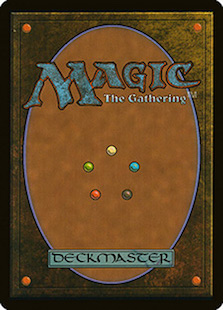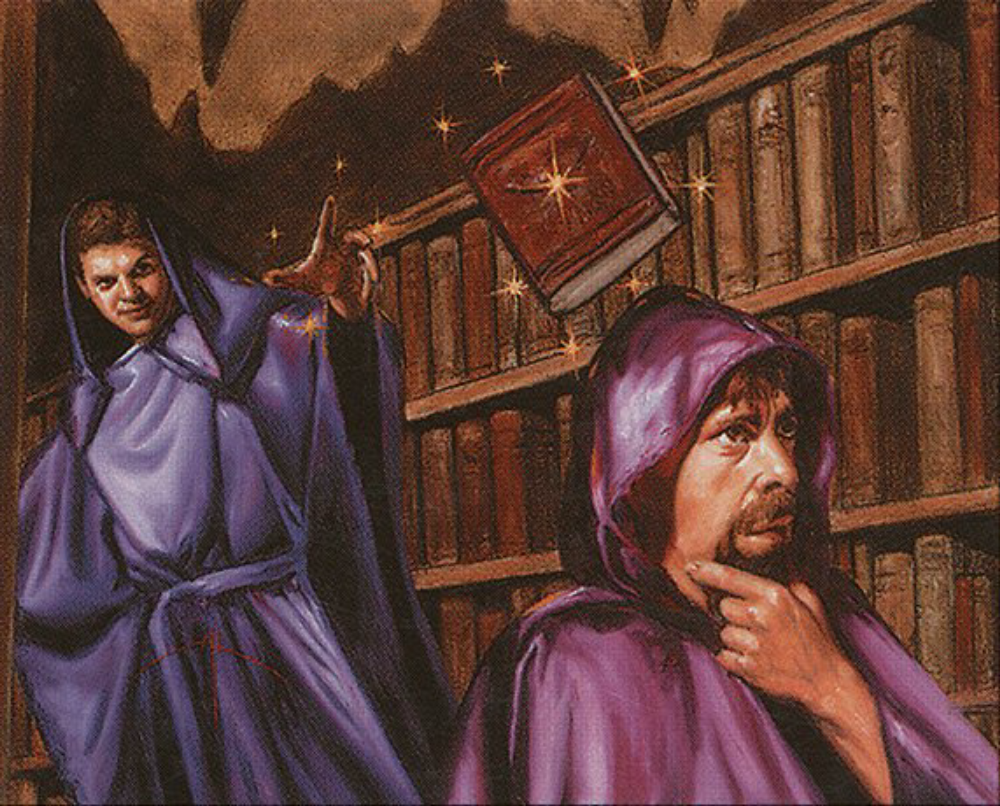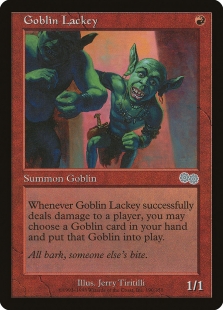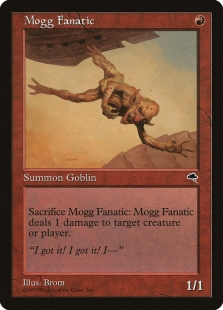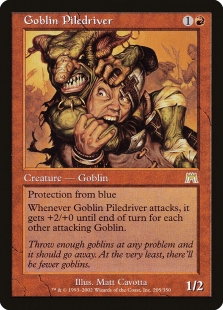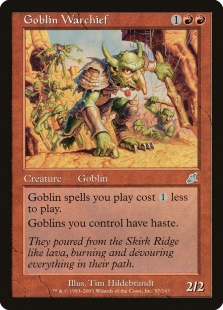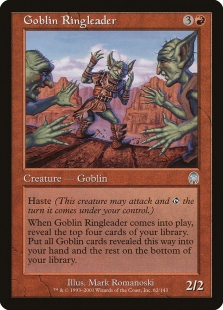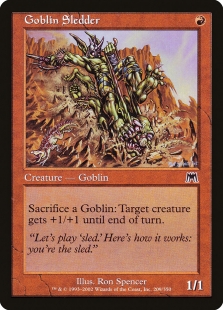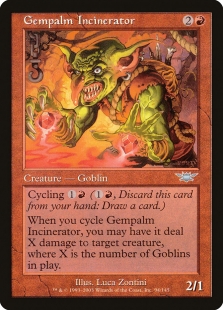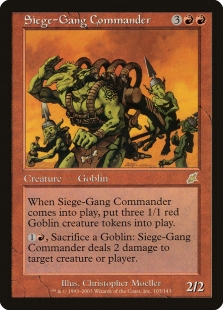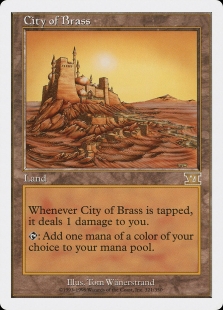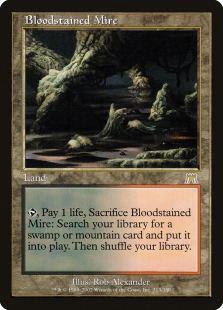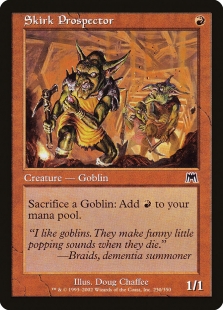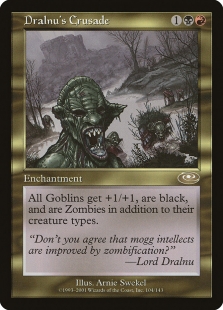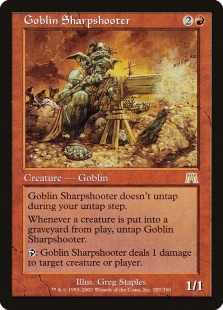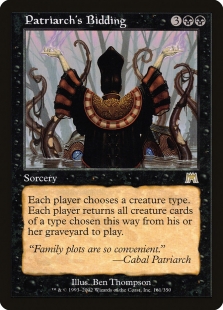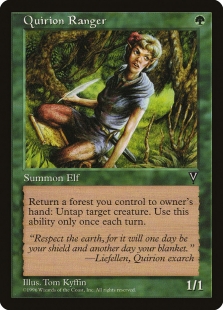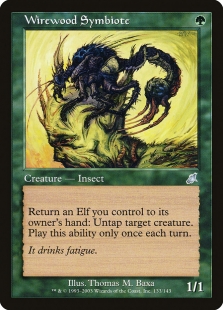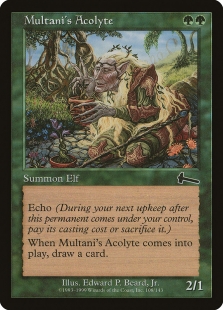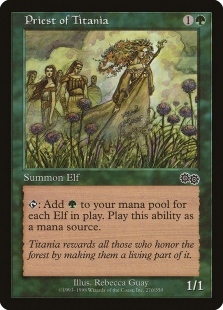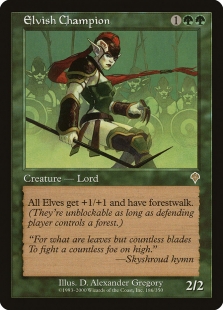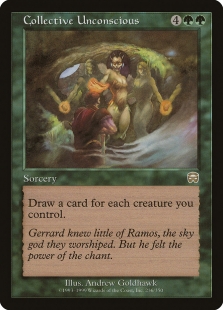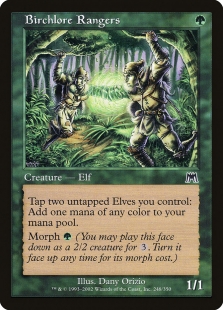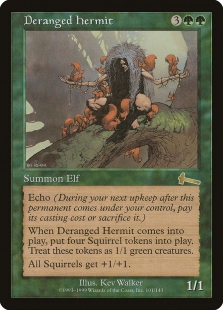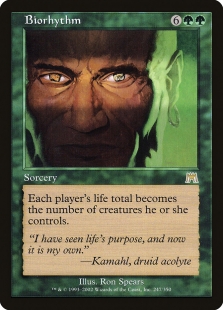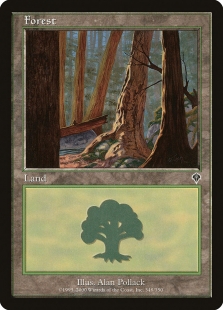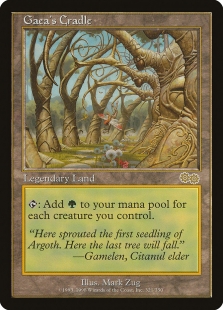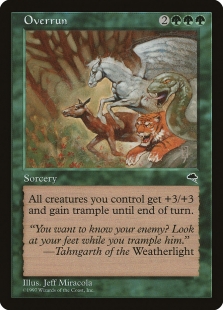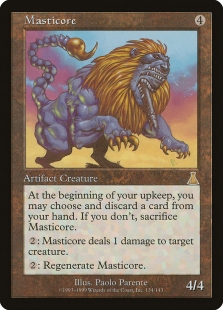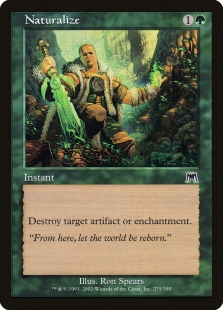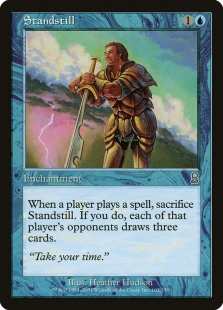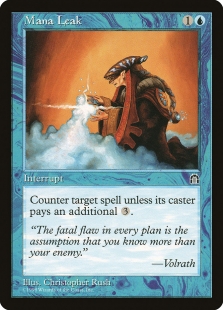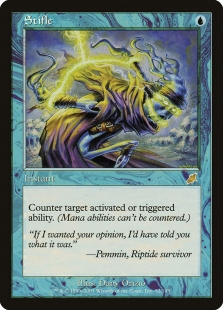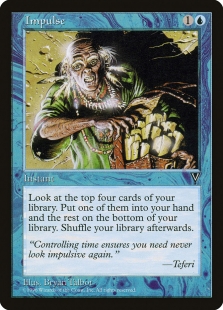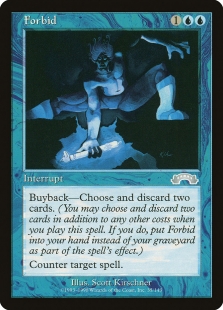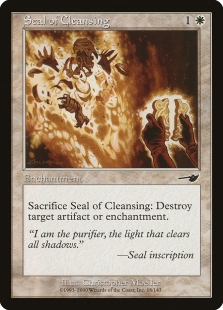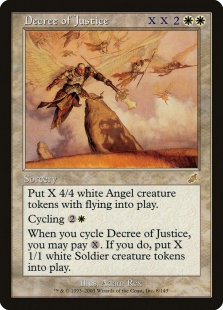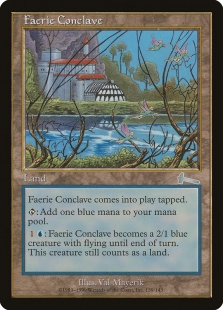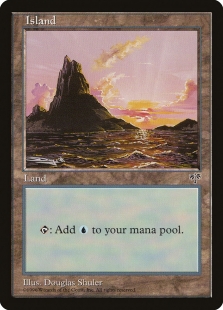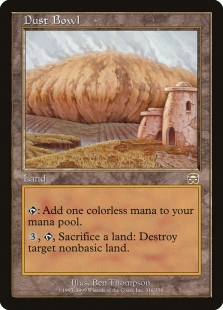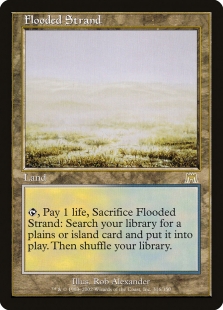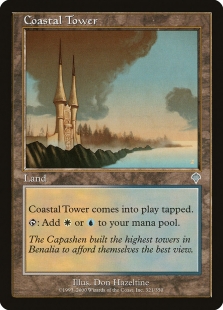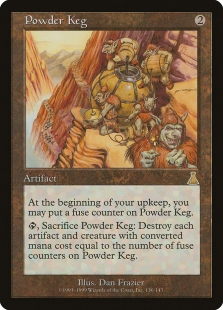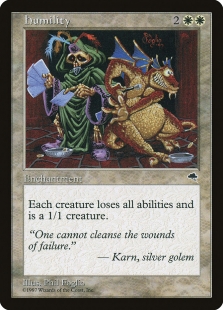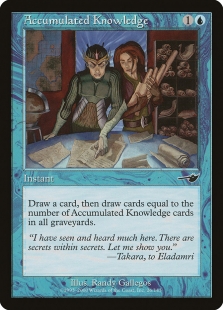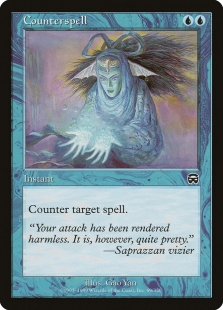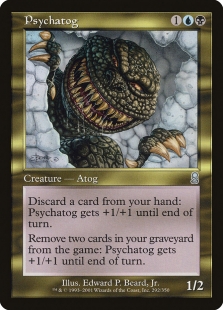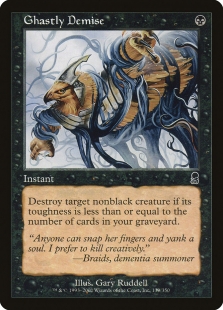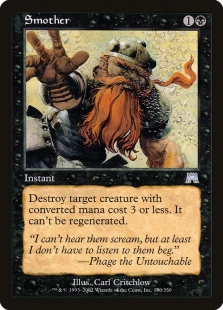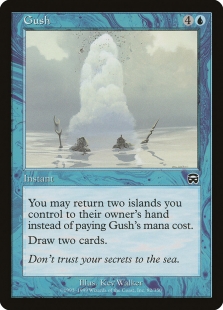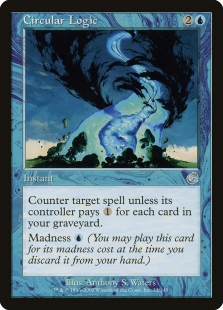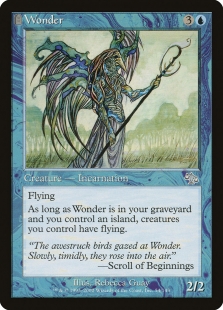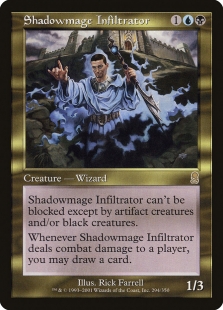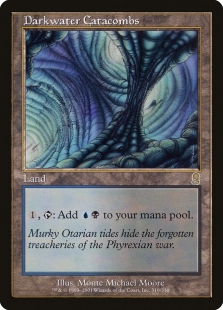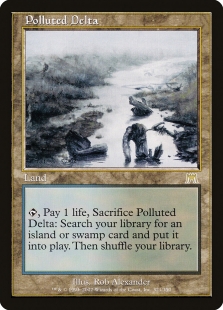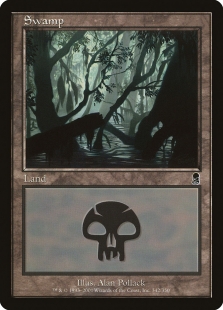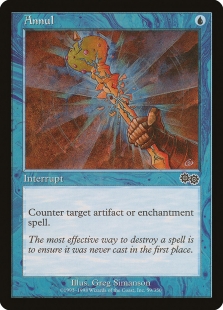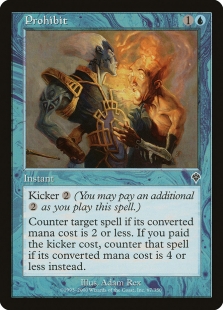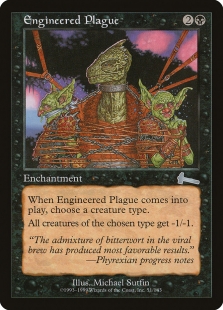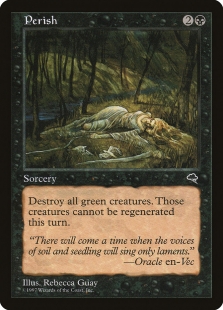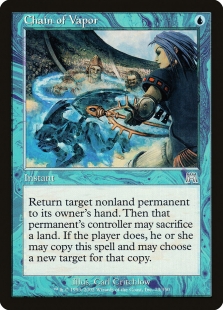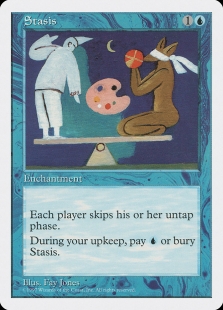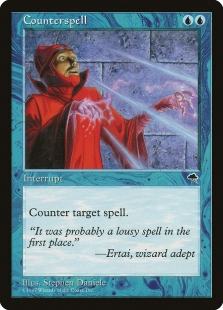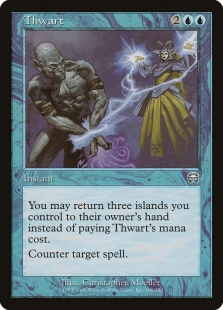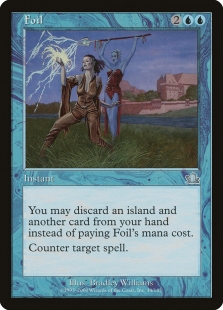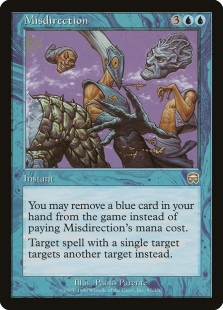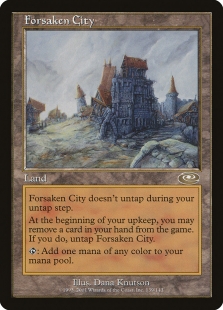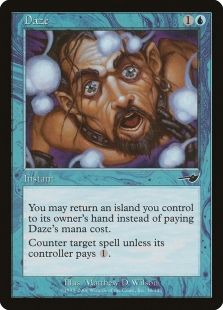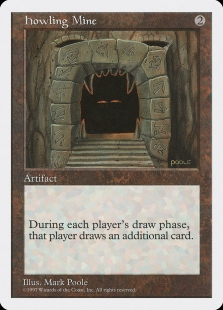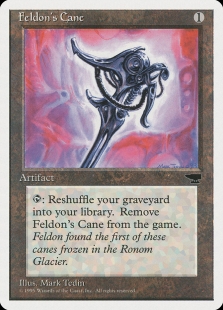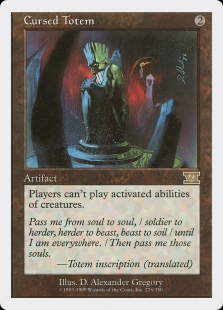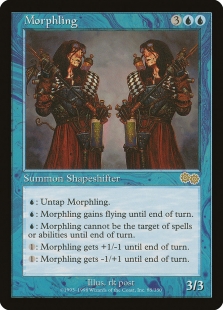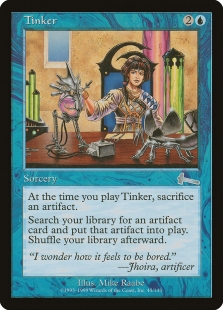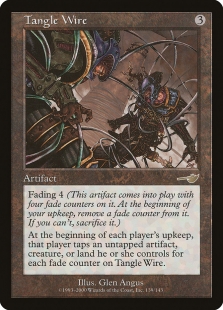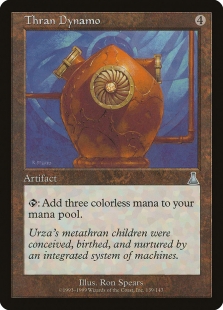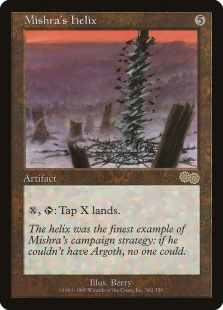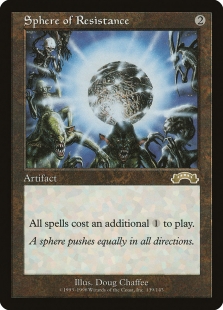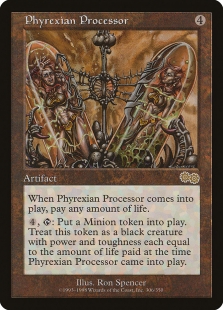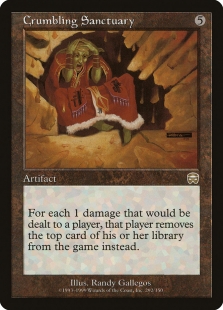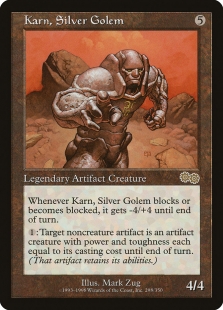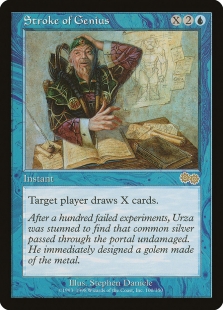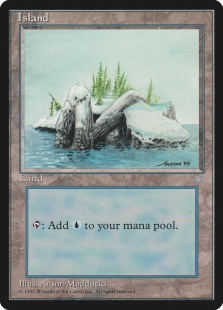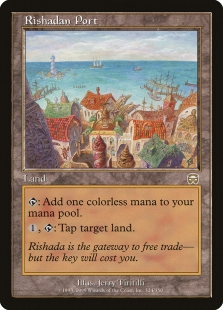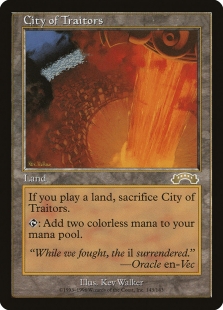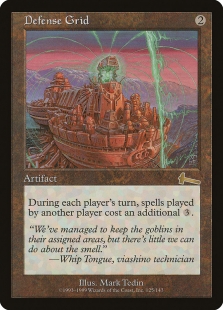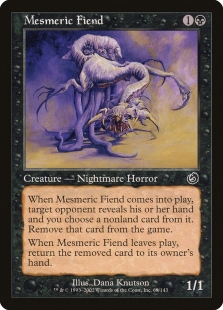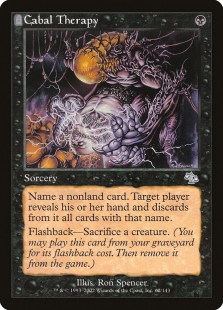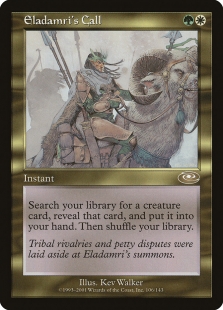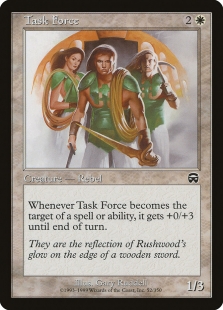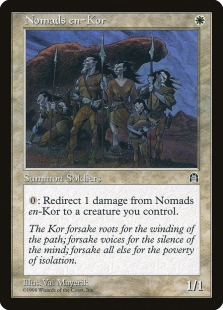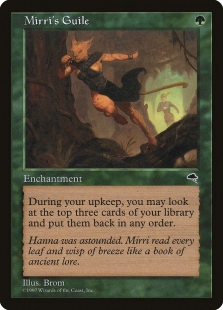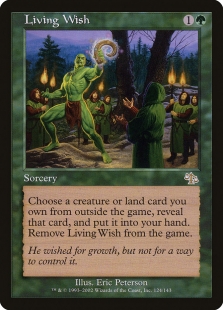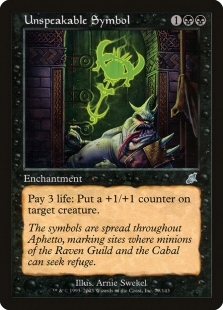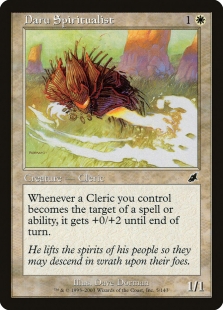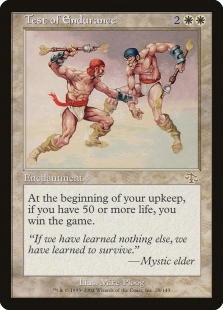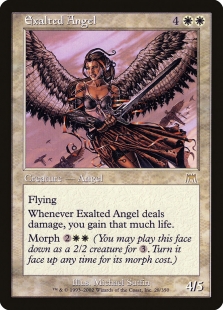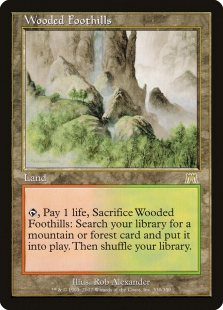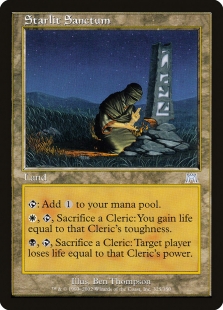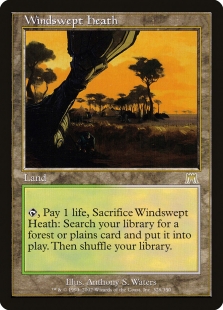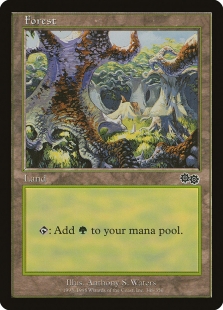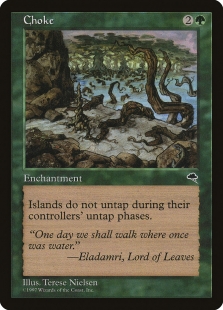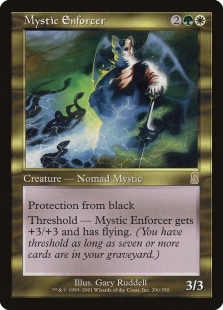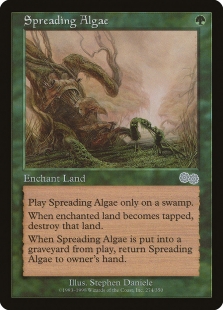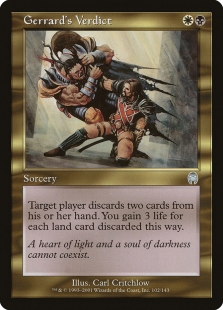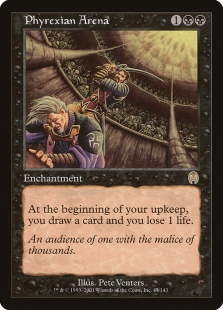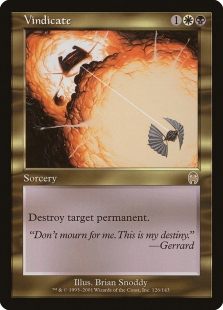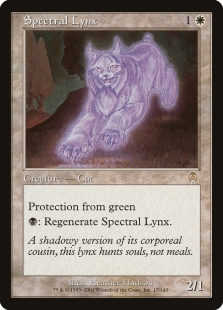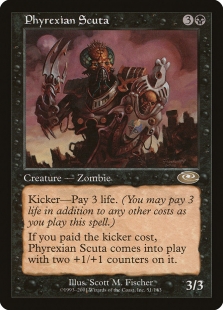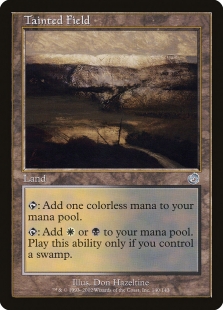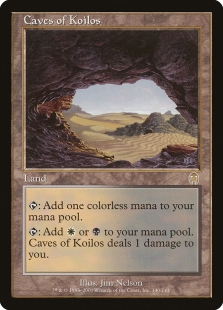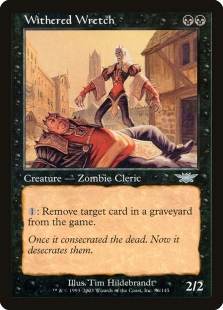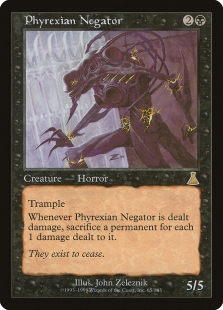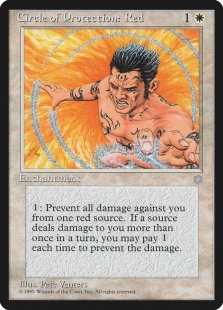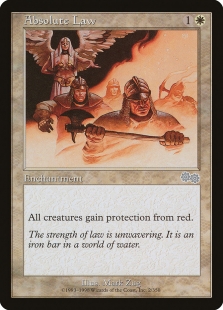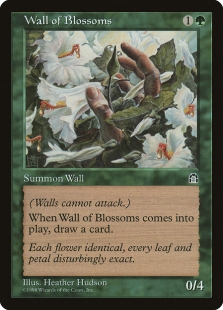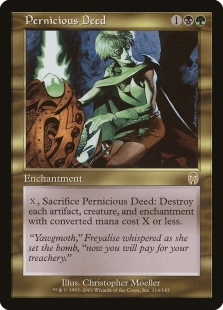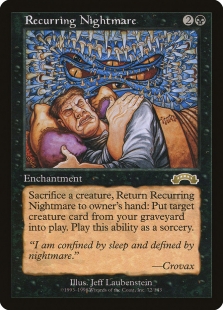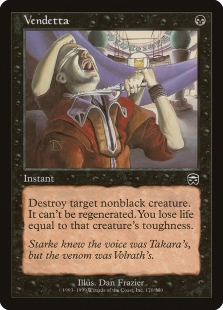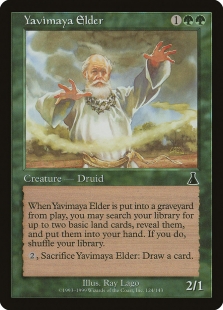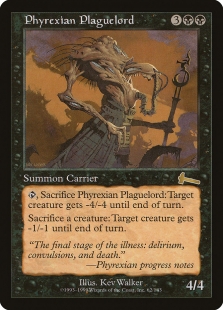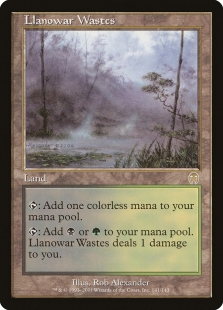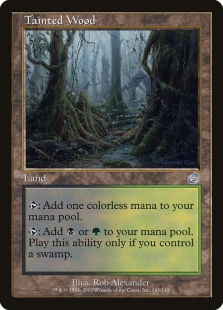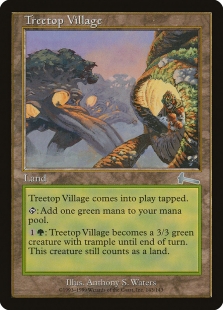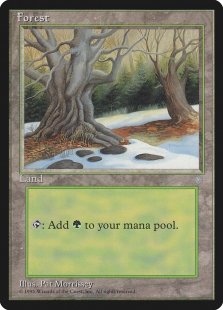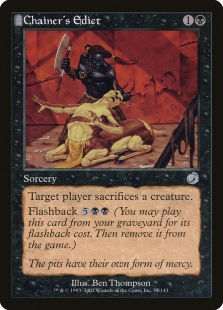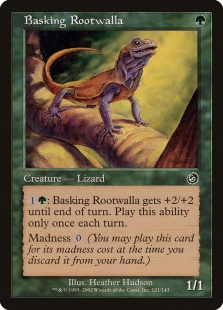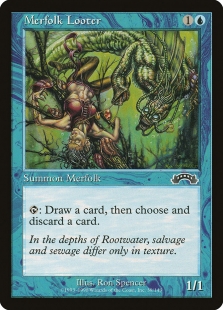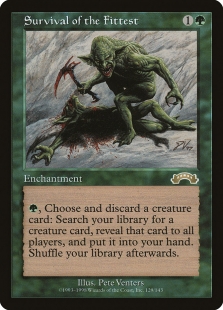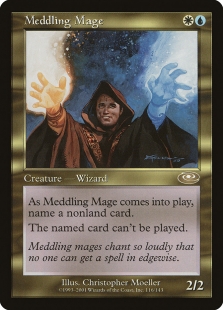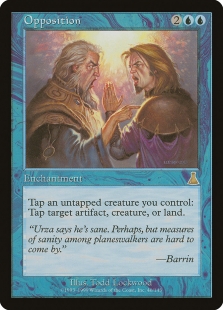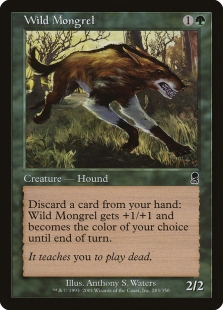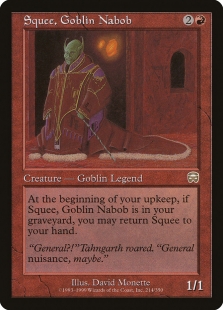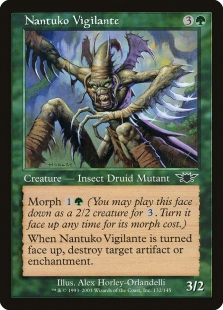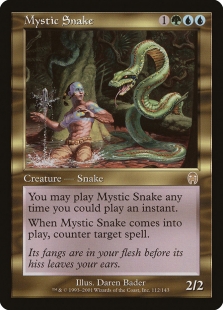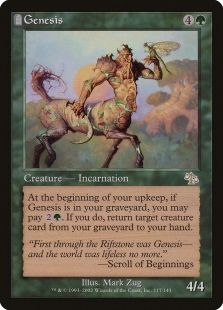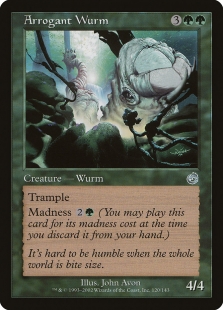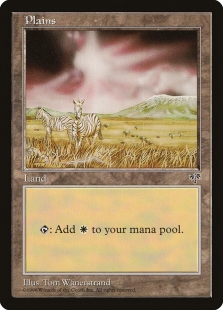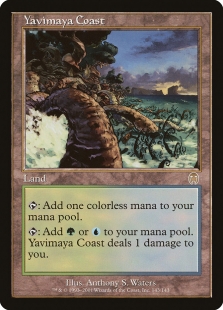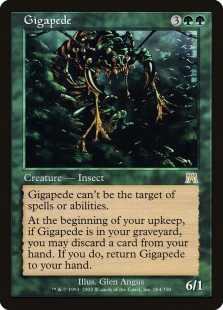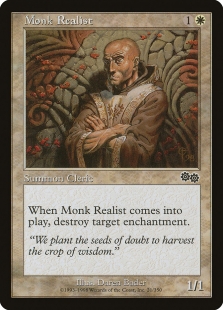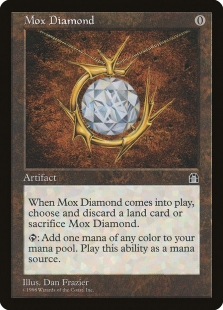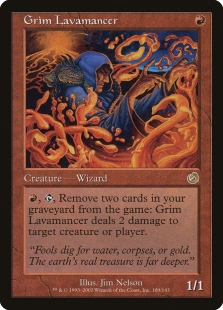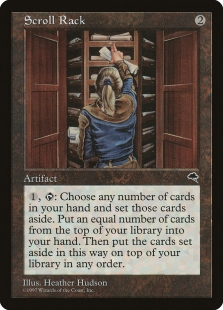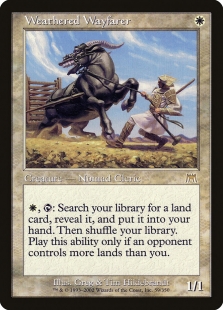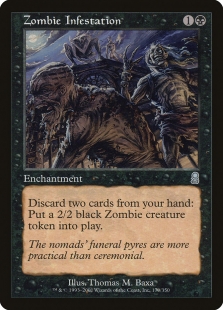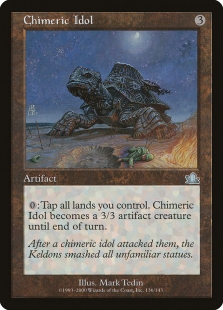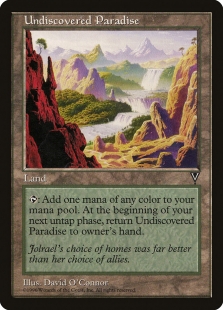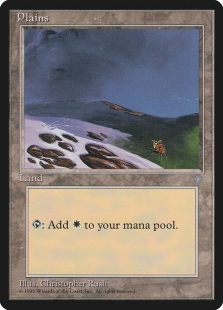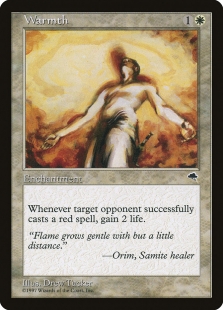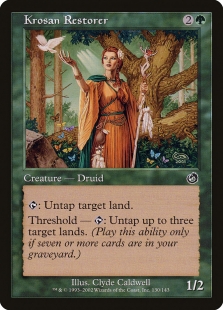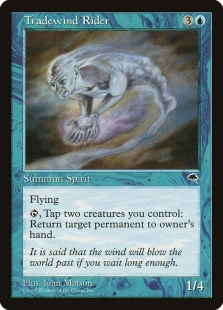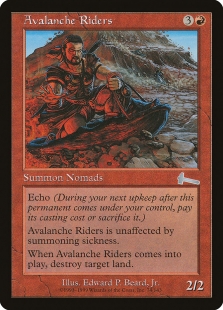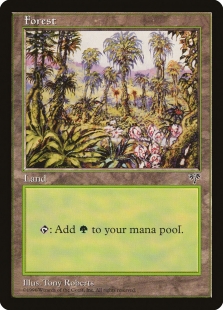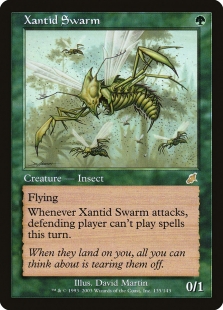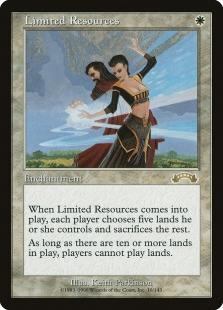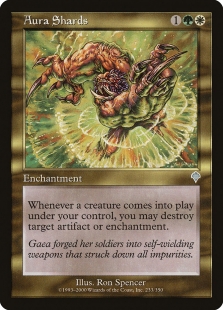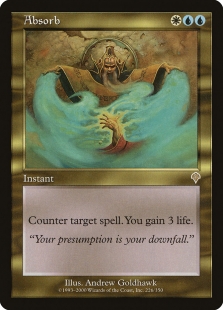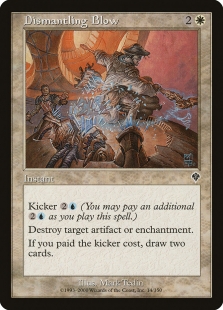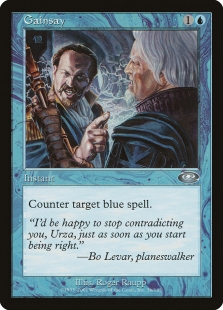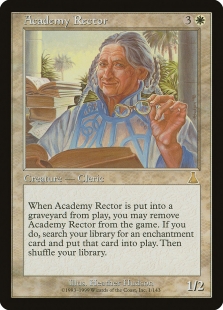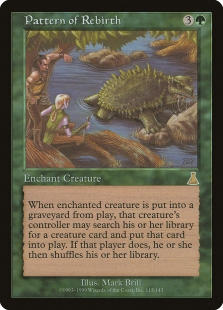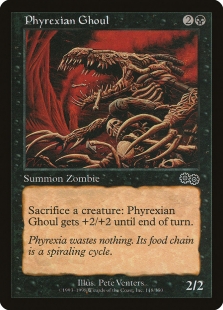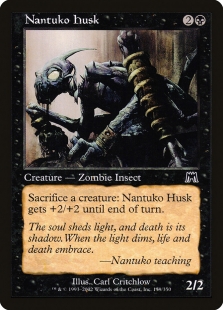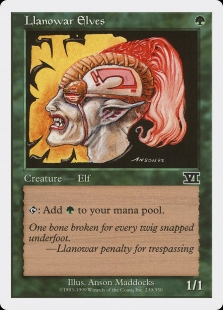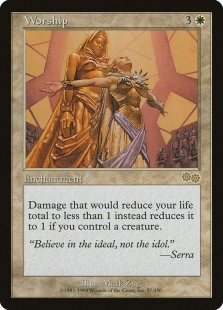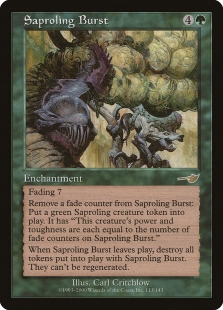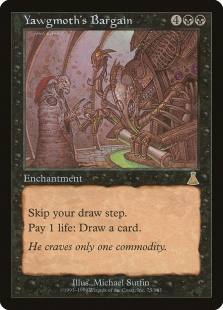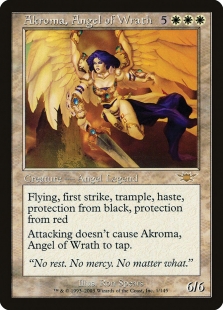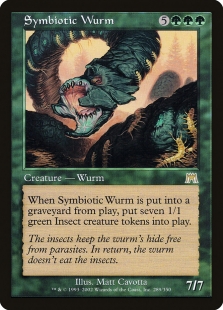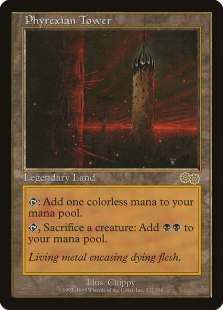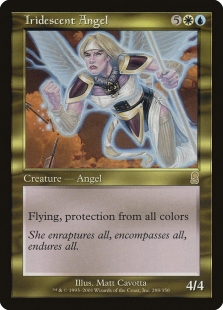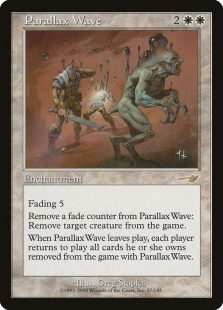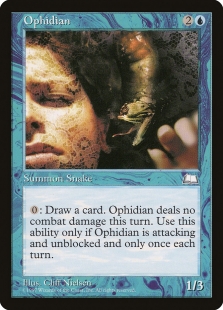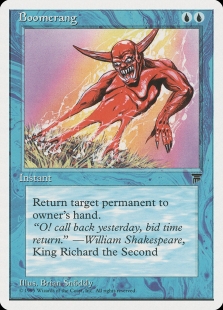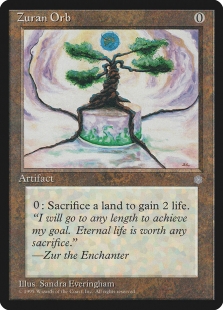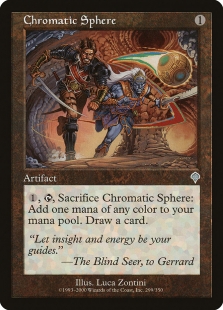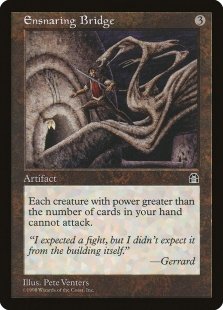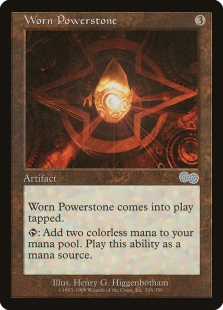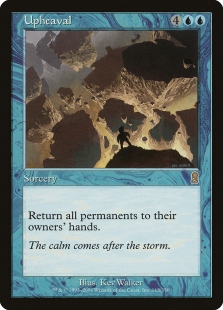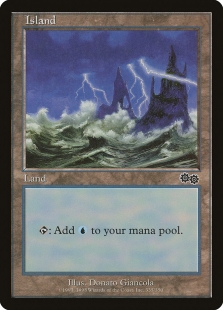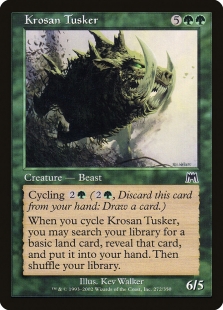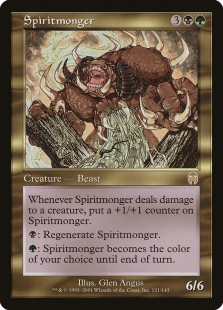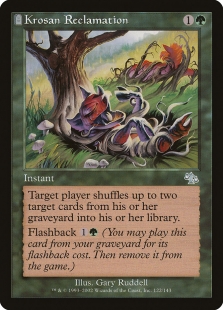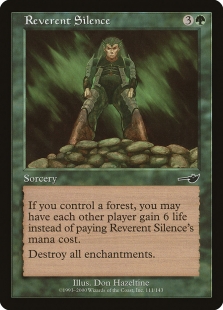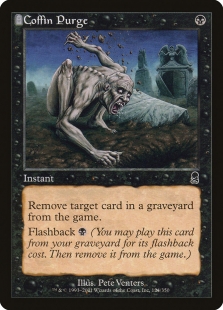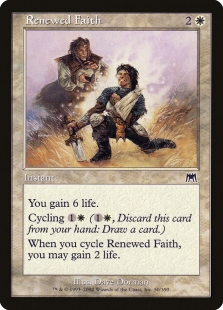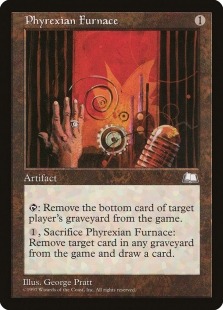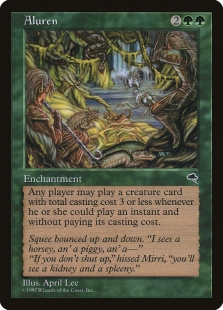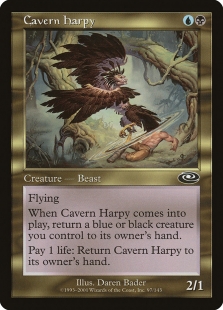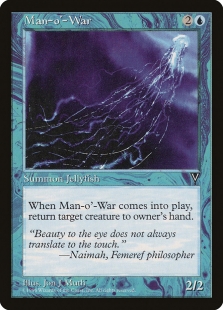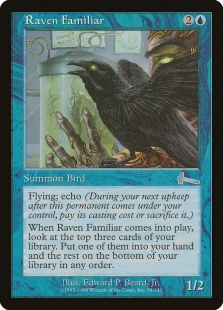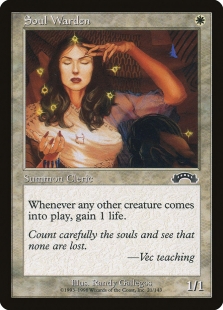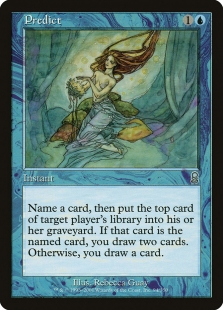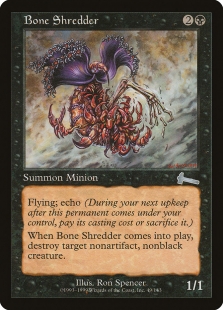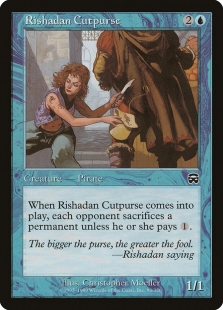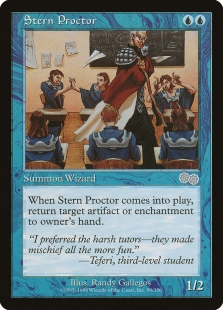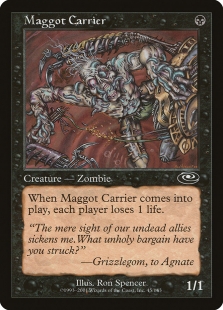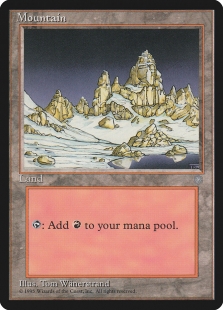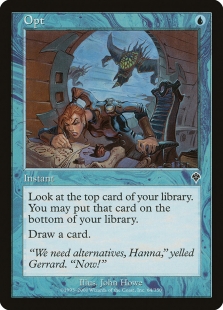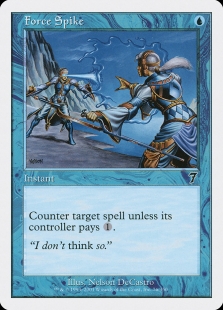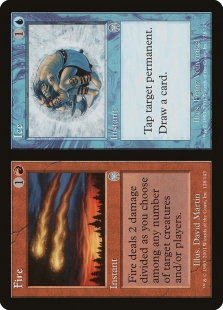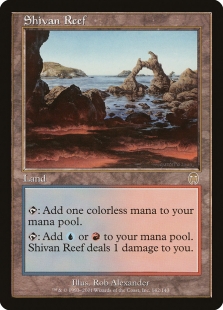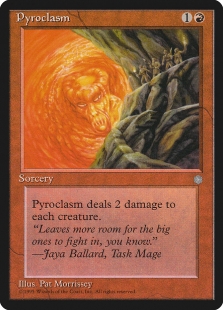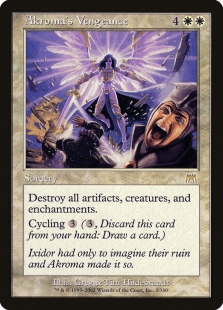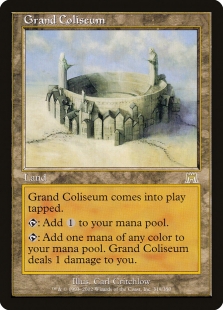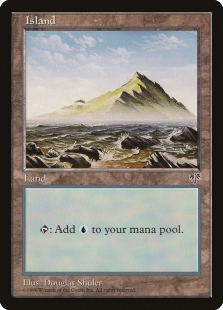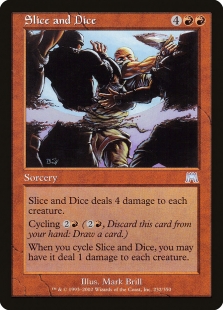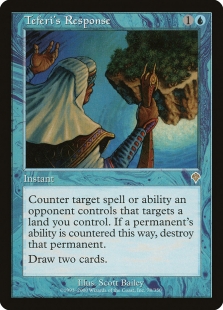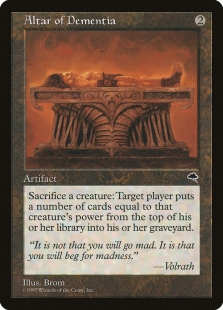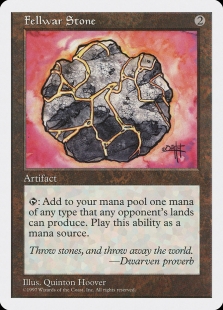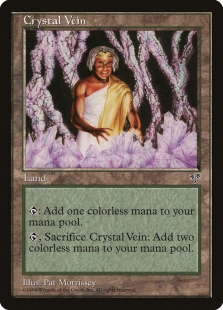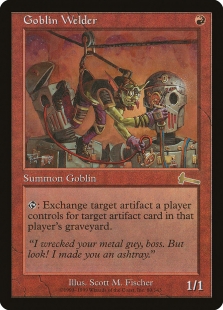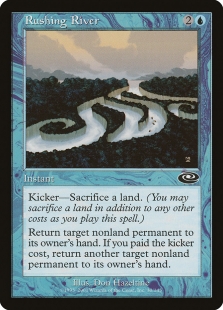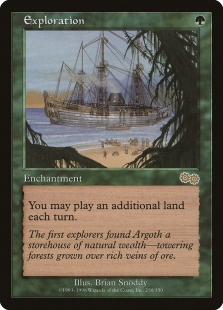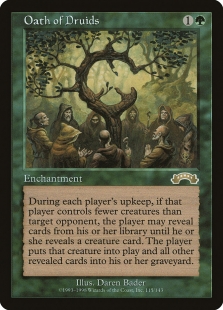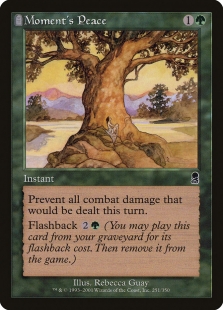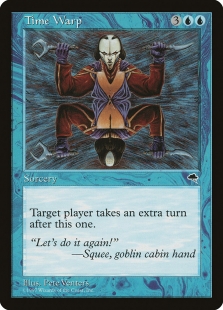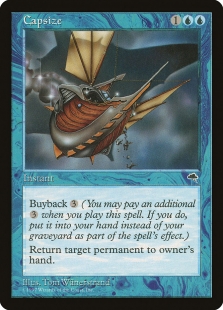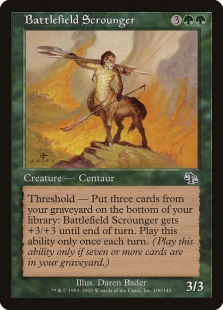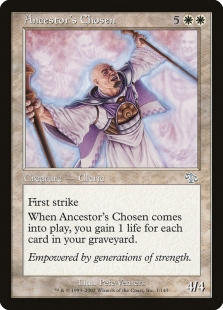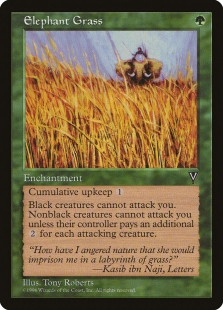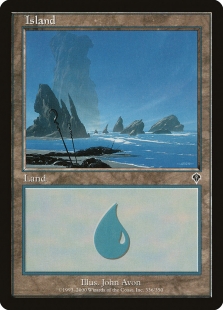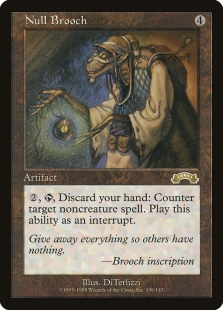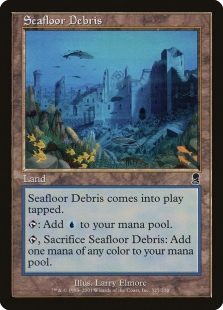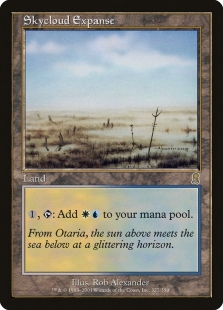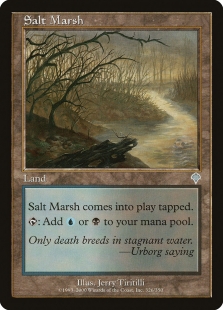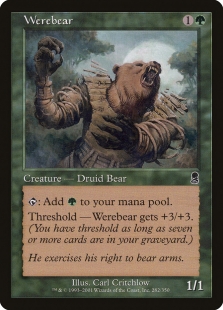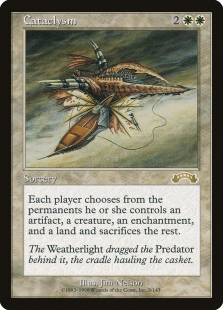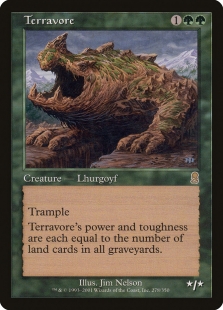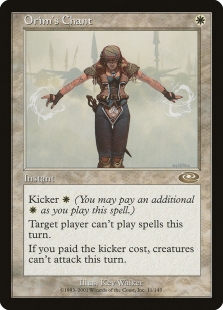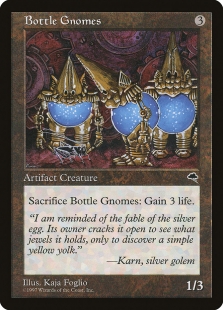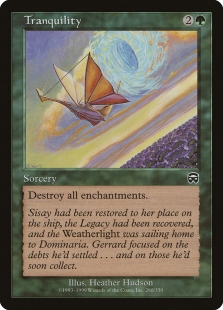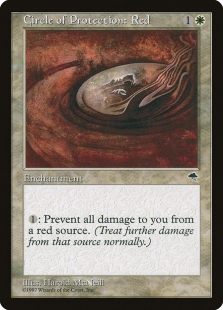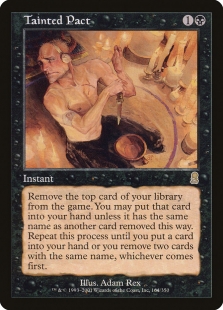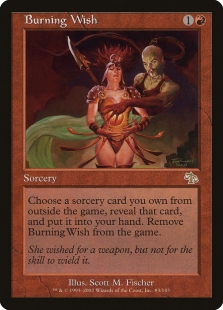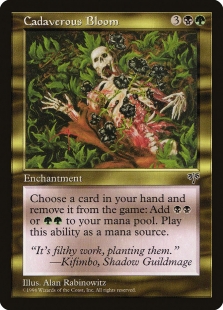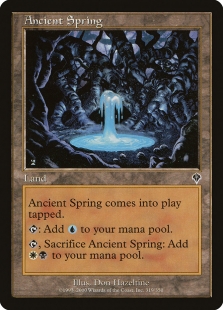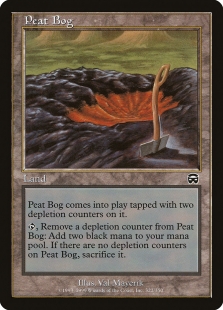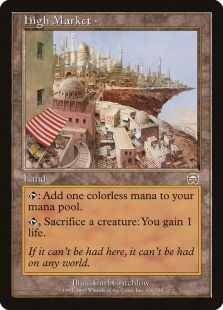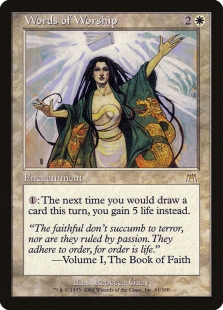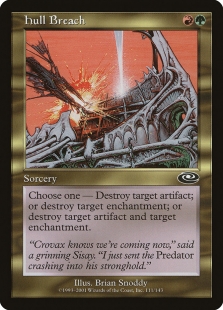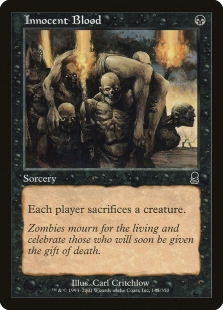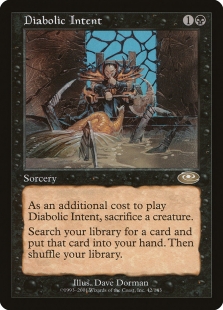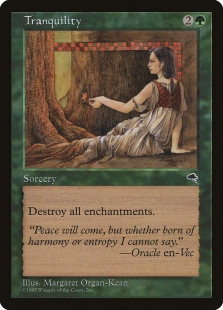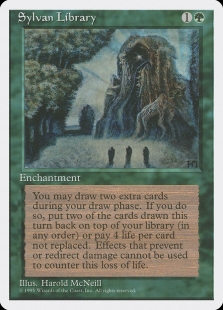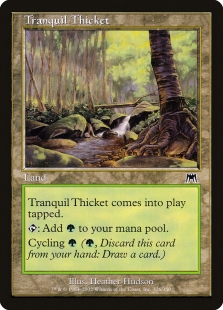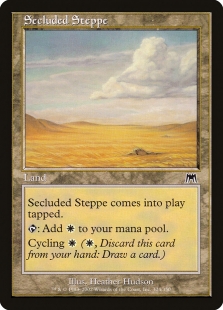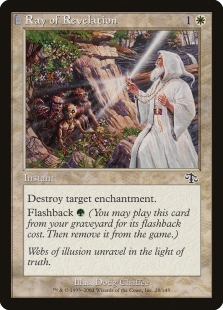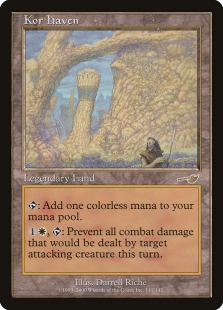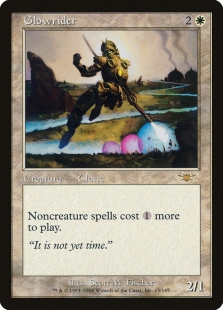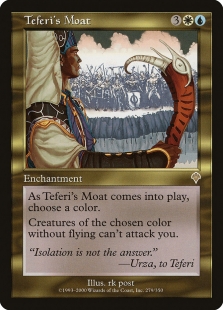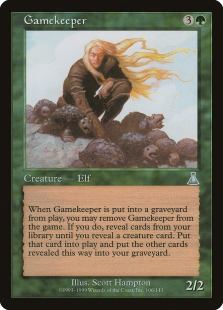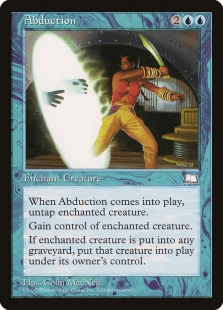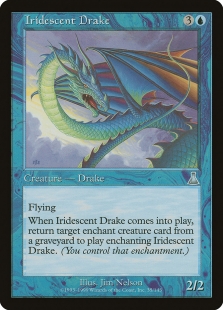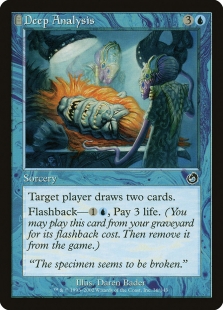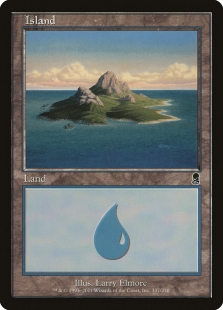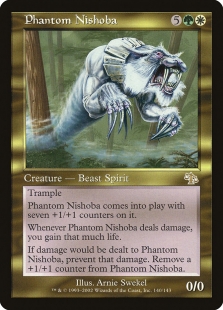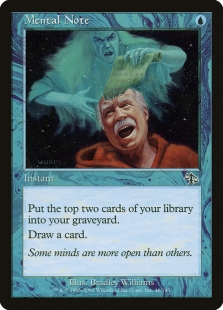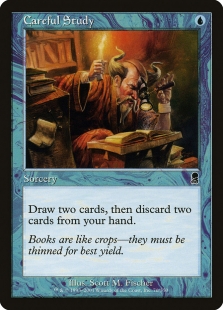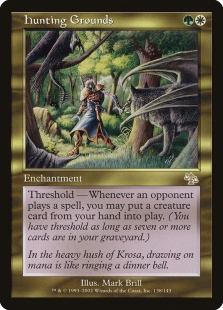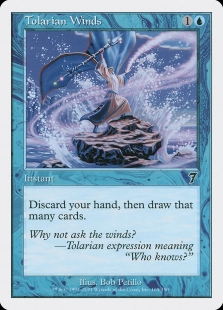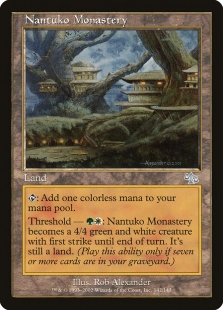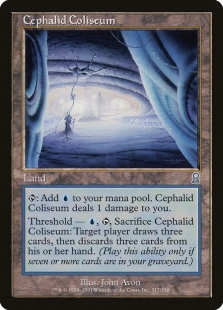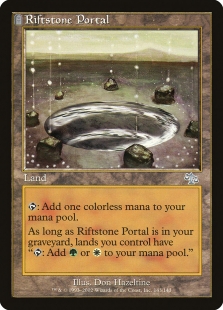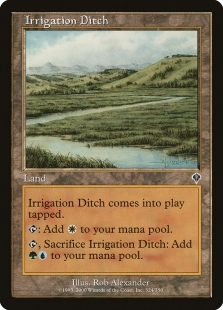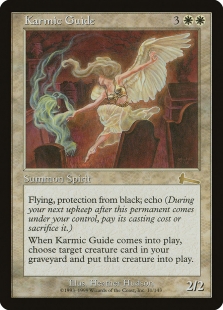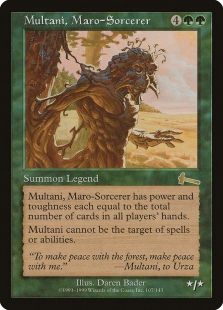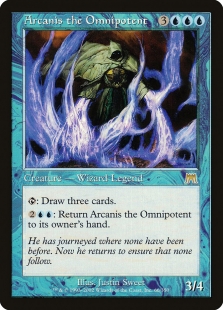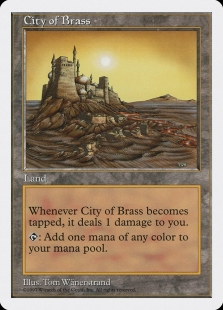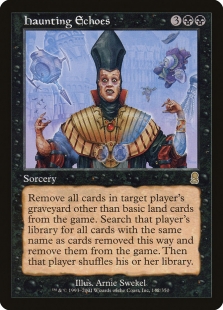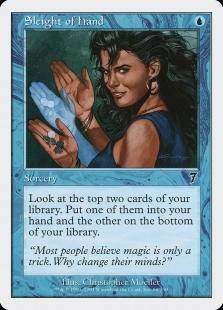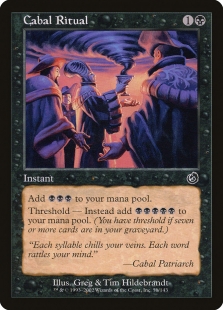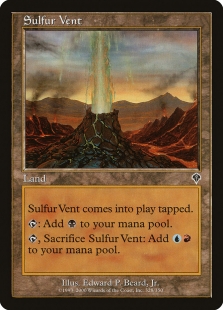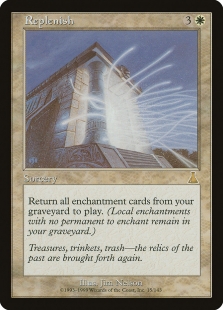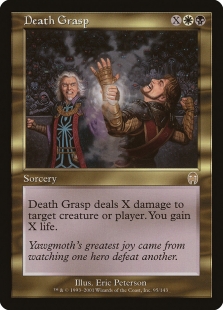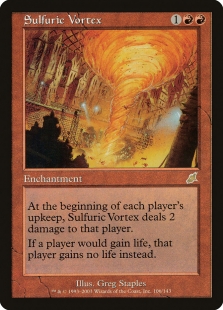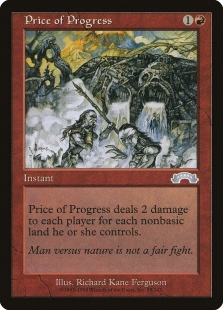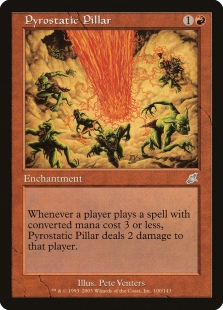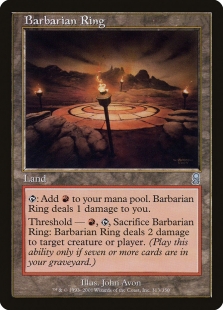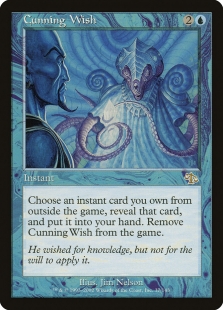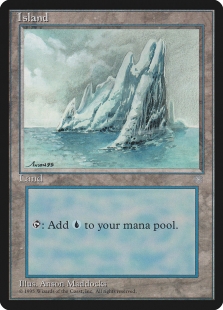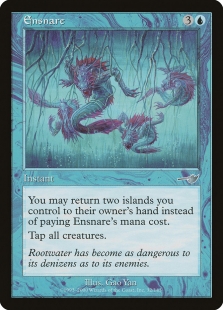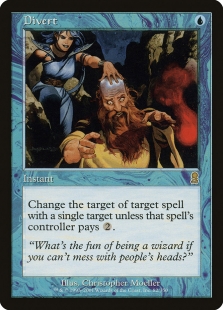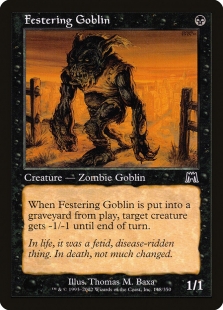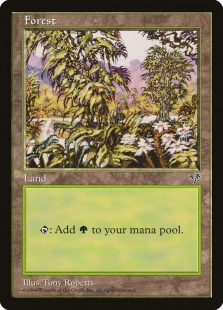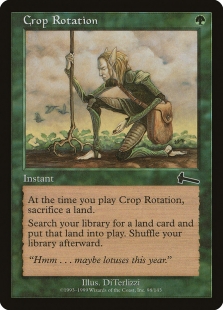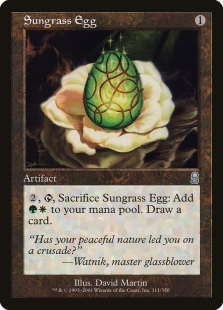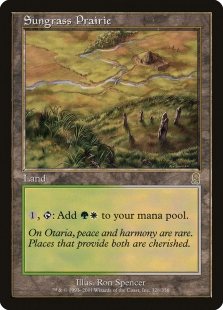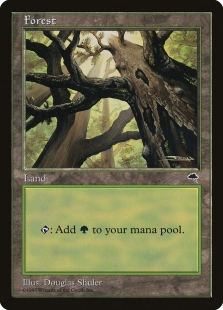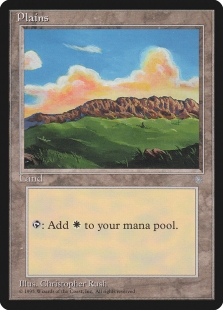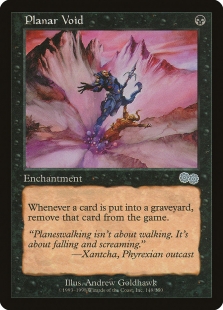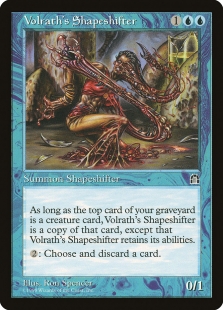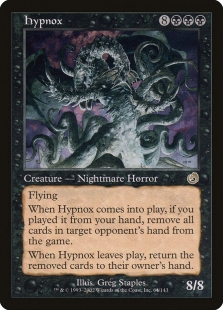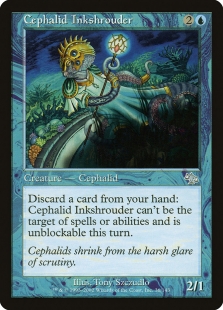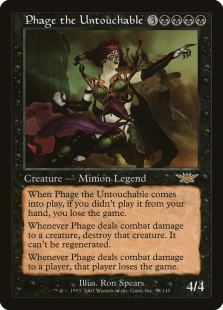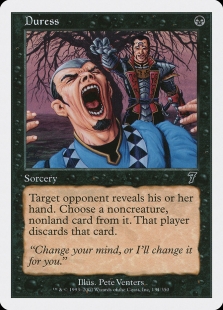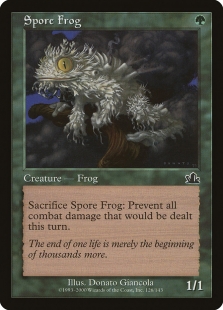In this article I do an overview of different Premodern deck archetypes, using the decks from the Swedish Nationals as examples.
In my report from the Swedish Nationals, I showed the top 8 decks and commented particularly on the breakout Devourer Combo deck and the Dementia Drake deck. Aleksi Väänänen also wrote a deck tech about the GW Tron deck that Sakari Castrén played. Erkka Jouste and runner-up Ville Kaukoranta also wrote an in-depth report from the tournament, covering their experiences with UW Standstill, Full English Breakfast and, umm, what they had for breakfast. But there were, of course, other interesting decks played as well, in the rest of the top 8 and among the remaining 38 players. I’ve also received quite a few comments asking to see a particular deck, so in order to please all of you netdeckers and statistics nerds, this post includes two appendices with all 46 deck lists and the final Swiss standings, showing the performance of each player and deck. If you didn’t know already, the decks look best when browsing in desktop mode, in which case they are shown as pictures.
As an aside, this is enabled by an online deck list submission system through the website (courtesy of the web wizard Mattias “Slanfan” Berggren), which we tried out for the first time in this tournament. This system provided some validation for the players, since it was only possible to select Premodern legal cards, and there was a warning when trying to submit fewer than 60 cards in the main deck etc. From an organizer’s perspective, it made it possible for us to show the decks on the stream, and it makes it possible for me to push the decks to a blog post like this, without having to manually decipher and input a huge pile of hand-written paper lists. Yay! The whole thing worked smoothly, so the plan is to use the same system for the European Championships in October.
Deck archetypes in Premodern
In order to show the forest rather than the trees, I’ve classified the decks into five broad archetypes: aggro, control, prison, combo and midrange. This classicification isn’t original per se, but this is how I interpret the archetypes in a Premodern context.
The main plan of aggro decks is to play cheap threats and reduce the opponent’s life total to zero as quickly as possible. These decks don’t care much about “value”, i.e. card advantage and other resources like one’s own life total. A Suicide Black player is happy lose a card by playing a Dark Ritual to get some creatures out quickly and doesn’t mind taking damage from cards like Carnophage and Flesh Reaver, as long as the opponent can be hit even harder. Likewise, a Sligh player is happy to lose a card by directing a Lightning Bolt to your face.
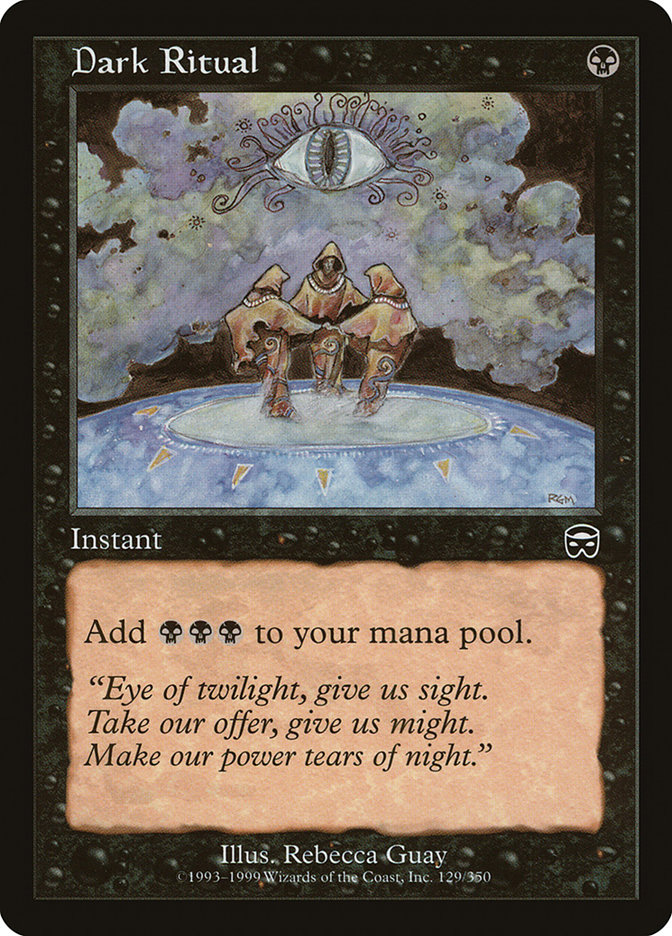


Aggro decks could still deliver some value or staying power, e.g. in the form of Goblin Ringleader or Cursed Scroll, but it’s just not the main plan. In Premodern, we expect aggro decks to typically win around turn four or five in goldfish mode, i.e. if they’re not hindered. Turn three kills are uncommon but possible, if you get really good hands with cards like Hatred, Fireblast and Goblin Lackey.
Control decks, on the other hand, go for a longer game and care a lot about value. They are happy to play mana efficient reactive one-for-ones like Counterspell, Swords to Plowshares and Disenchant. As long as they stay alive, they will eventually get ahead with draw spells like Standstill, Fact or Fiction and Accumulated Knowledge. Board sweepers like Wrath of God can gain card advantage but also regain “tempo” at the same time, in the sense that your opponent has spent more mana and turns summoning the creatures that are destroyed.

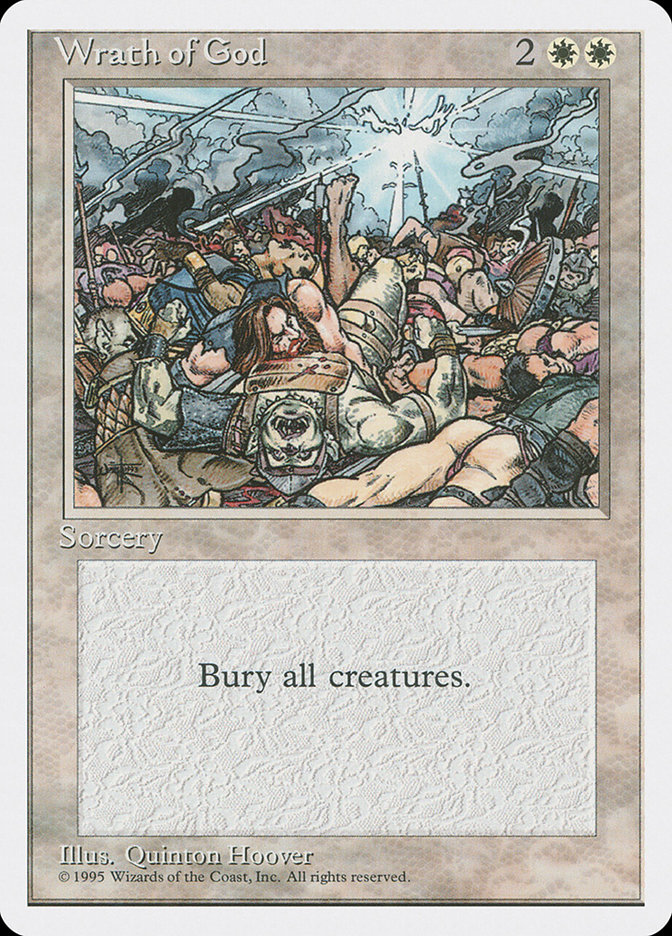
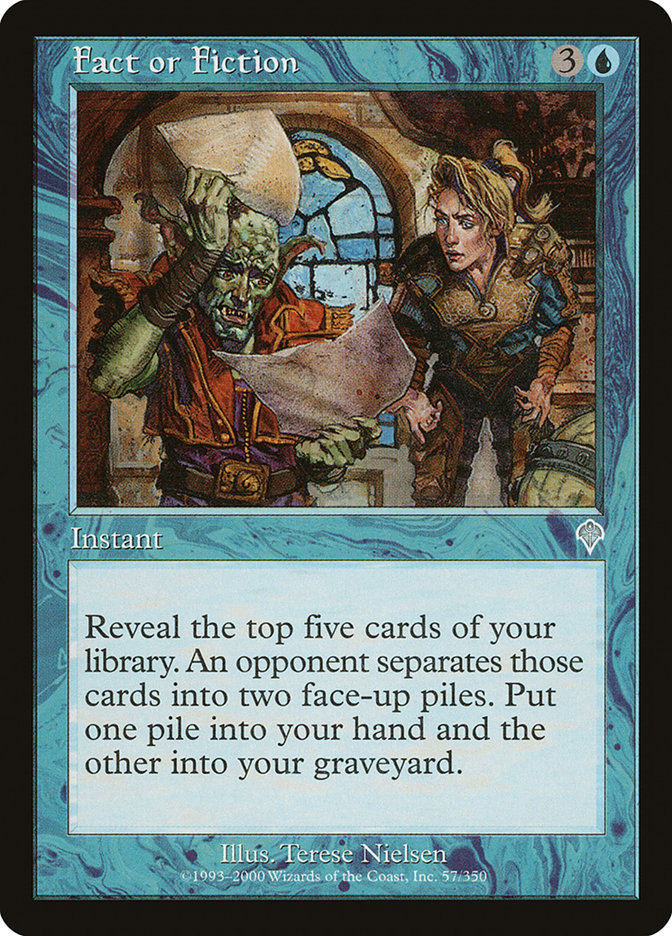
Prison decks are similar to control decks in that they also go for a long, controlling game. But rather than relying on more or less situational one-for-one answers, they gain control by shutting down the opponent’s plan completely, with powerful reactive cards such as Solitary Confinement and Ensnaring Bridge. Hard core prison strategies shut down the opponent’s mana, with cards like Winter Orb and Mishra’s Helix. Both the soft and the hard prison elements create indirect card advantage, by making your opponent’s cards useless. Some of the most powerful prison cards could simultaneously shut down both your opponent’s creatures and mana, like Stasis, Devastating Dreams and Tangle Wire.
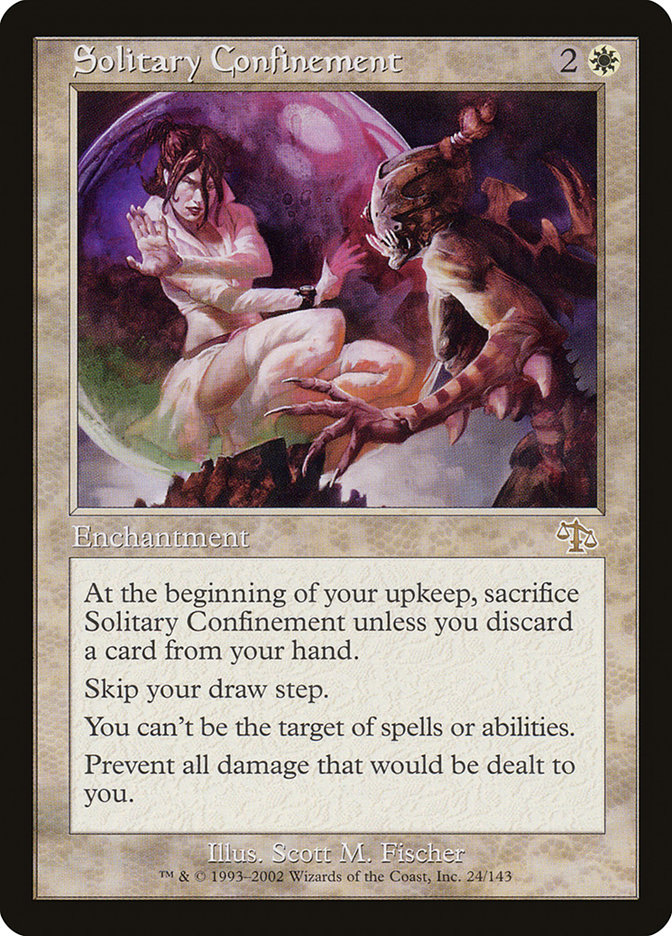


Prison decks can create very fun games, but that fun is not distributed evenly between the players. Whichever side you’re on, we have to live with the fact that there are quite a few potent prison cards in Premodern. This is in contrast to the the card design philosophy in more recent sets, in which not even a card like Stone Rain would get printed.
Magic is a game full of combos, e.g. Thicket Basilisk and Lure. But jamming these two in your lizard deck doesn’t make it a combo deck, which is instead characterized by that it’s built around a more or less degenerate card combination or engine that wins the game on the spot or within a few turns. An example is the mono-blue Trix deck—it’s only route to victory is by Donate‘ing an Illusions of Grandeur. Besides the actual combo cards, most combo decks typically include a mix of mana acceleration, card filtration and tutors, e.g. Sapphire Medallion, Impulse and Intuition in Trix.

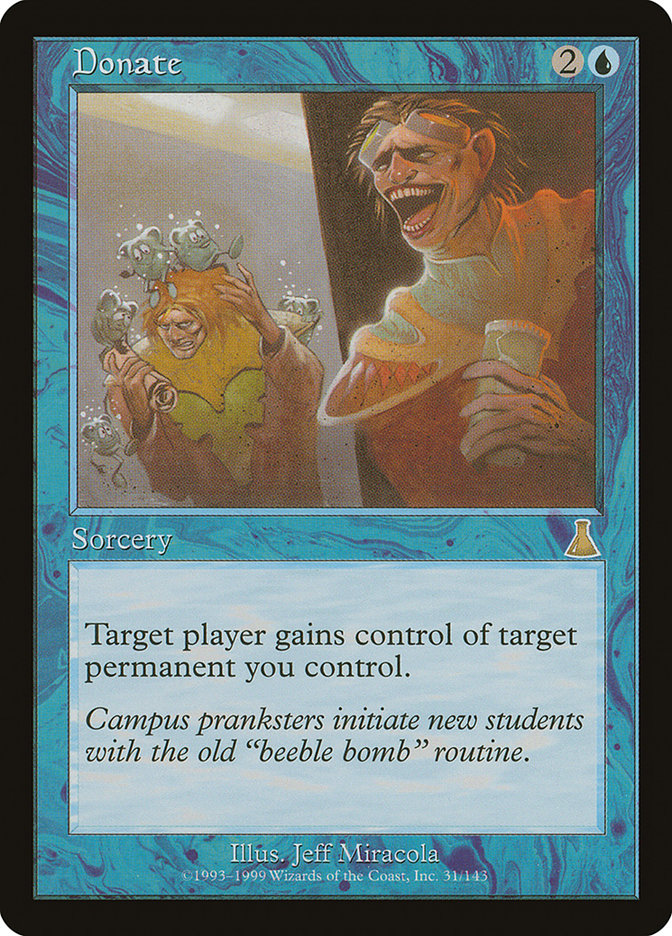
In a nutshell, a deck can be classified as combo if it’s unable to win if the opponent could remove all copies of a certain card from the deck. We could call this the Jester’s Cap test (pretending that we could grab four instead of three cards). Combo decks typically want to be faster than the aggro decks. In Premodern this means being able to win on turn three or four, if undisrupted. However, combo decks may include some amount of disruptive and reactive cards to buy additional time or to protect the combo, e.g. Cabal Therapy or Arcane Denial. Combo decks don’t care about value, unless it’s drawing cards instrumental for setting up the combo.
Last, we have the midrange decks. I think of this in a broader sense as sort of a residual category, including decks that share characteristics of the other four categories, but without clearly belonging to either one of those (it could thus also include hybrid strategies such as “aggro-control” or “combo-control”). As the name suggests, midrange decks typically don’t aim for a quick nor for a very long game. They care about value, to varying degrees. Ideally, they can be flexible and take a controlling role versus aggro decks and an aggressive role versus control decks. They want to play bigger threats than the aggro decks, but the trade-off is that they can’t be too slow versus the control decks. Ravenous Baloth is a midrange card which illustrates this well. Nantuko Shade is another example of a midrange card—it’s cheap to play but its power scales up as the game goes on, making it relevant at all stages of the game. Since the midrange decks are not that fast, they need to include a sufficient amount of disruptive and reactive cards in order to have a chance versus prison and combo decks. Midrange decks can also include a combo package themselves, but it’s not essential to their game plan.
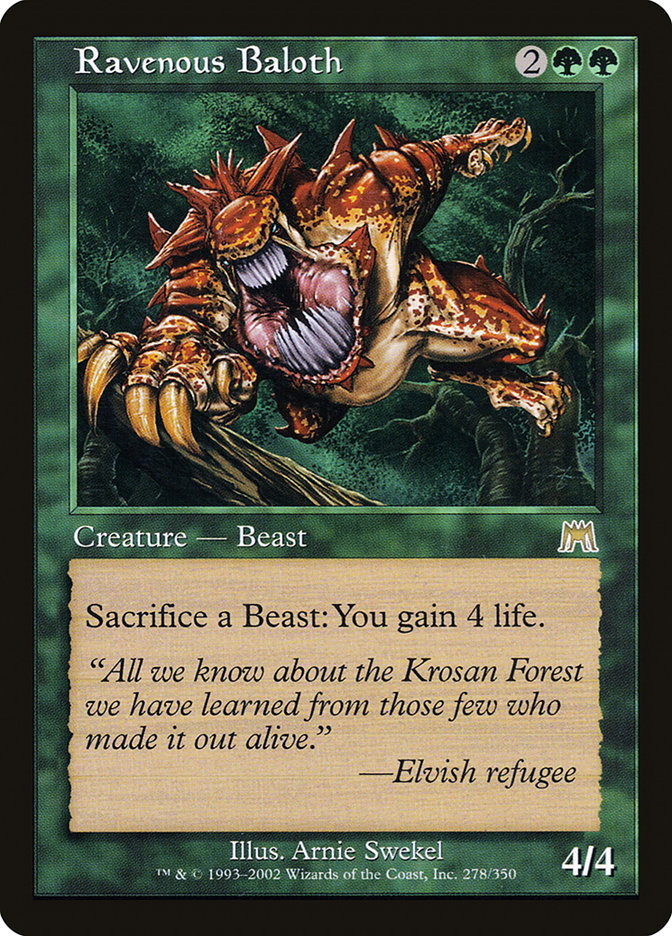
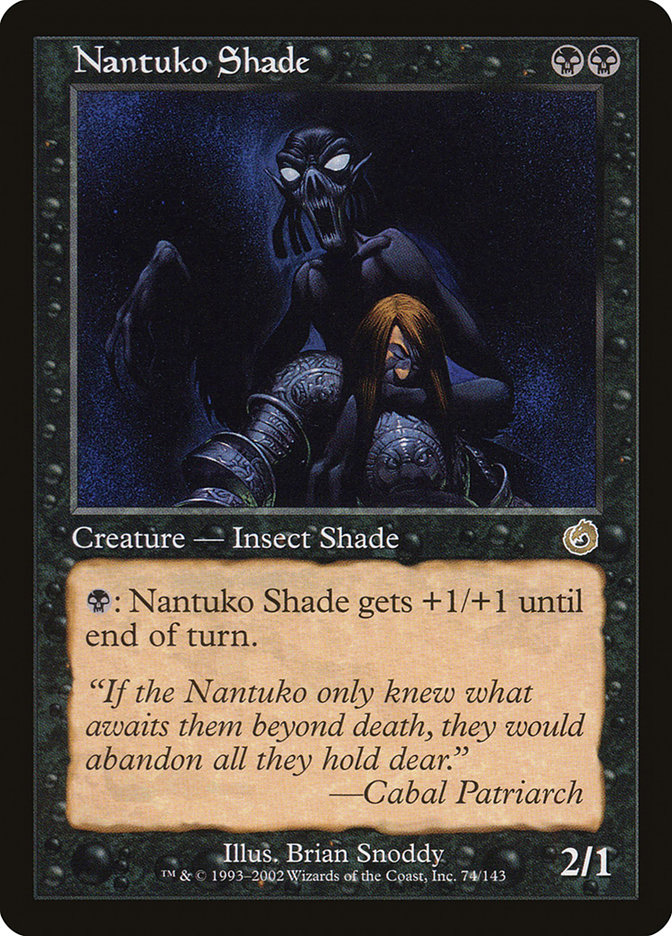
Archetype breakdown of the Swedish Nationals
The breakdown of the field, according to the broad archetypes outlined above, looks as follows:
- 12 Midrange (2 Terra-Geddon/Clysm, 3 The Rock, 1 RW Tax-Rack, 1 Survival Madness, 2 Deadguy Ale, 1 Hunting Grounds, 1 GW Tron, 1 UR Stifle-Nought)
- 12 Combo (1 Aluren, 3 Bargain, 1 Clerics, 1 Dementia Drake, 2 Devourer, 1 FEB, 1 Pattern-Rector-Ghoul, 1 TurboLand, 1 UB Stifle-Nought)
- 9 Control (5 UW Standstill 2 4c Control, 2 Psychatog)
- 9 Prison (4 Stasis, 4 Tinker, 1 Survival Opposition)
- 4 Aggro (2 Goblins, 1 Elves, 1 Land Destruction Burn)
Let me note there that there were some borderline cases, with decks that could arguably be assigned to a different category (and we’ll get back to that). Given this breakdown of the field, what general remarks can be made?
The first thing that stands out, and pointed out already in my organizer’s report, is that aggro made up only a tiny share of the field, with four decks. In particular, there was not a single Sligh deck, despite it being one of the best decks in the format. I think that this is more reflective of chance and local preferences, rather than due to people avoiding aggro for meta-game reasons (compare e.g. with the Euro Champs last year, which featured five Sligh decks). As for the chance part, there is always a random factor regarding what people and decks show up at a given tournament, and given the huge amount of decks available to choose from, a 46-player tournament is not big enough to even that out. As for preferences, a rather linear deck like Sligh may not rank that high on peoples’ pet deck lists, and for a special event like this, people are probably inclined to bring a well-loved deck. And there are plenty to choose from, even if you limit yourself to the competitive end of the deck spectrum. Finally, we should also keep in mind that not everyone plays this format to spike, which is perfectly fine of course.I do believe that aggro is in a good place in Premodern, however, and it would also be fun to see some more experimentation with, e.g., Suicide Black and Zoo decks (which Karl Pfeiffer’s wrote a deck tech about recently).
Second, combo accounted for around a quarter of the field, with 12 decks. This is a sizeable share, and I believe a larger one than in previous tournaments. Amazingly, there were nine distinct combo decks, with three distinct ones in the top 8.
Third, mid-range decks seem to thrive, accounting for another quarter of the field with 12 decks. But do keep in mind that this is a rather broad umbrella of decks.
Fourth, control decks accounted for one fifth of the field, with nine decks, and equally many Prison decks showed up. If we choose to view Prison as a control deck species, their combined numbers actually made up the largest share of the decks.
Is there a “natural” or expected distribution of decks then, in terms of these archetypes? Not really, I’d say. My best guess about future Premodern tournaments is that each archetype will account for at least 15% of the field, but I wouldn’t raise my eyebrows that much regardless of how the remaining 25% of the field was distributed among the archetypes. Some Magic theorizing suggests rock-paper-scissors dynamics among archetypes, e.g. with aggro beating control beating midrange beating aggro. But in Premodern (and this is probably more true than not for other formats, too), I think it more comes down to the specific decks and their matchups, and even the particular configuration of the decks.
The decks
Let’s have a closer look at a couple of decks within each archetype.
Aggro
MAIN DECK | 60 cards
Instants and Sorceries: 4
Deck downloaded from - http://premodernmagic.com
------------------------------------------------
Swedish Nationals 2019: Vidar Hesselman
------------------------------------------------
MAIN DECK (60)
Instants and Sorceries: 4
4 Duress
Creatures: 32
4 Goblin Lackey
4 Mogg Fanatic
4 Goblin Piledriver
4 Goblin Warchief
4 Goblin Ringleader
2 Goblin Sledder
2 Goblin King
3 Gempalm Incinerator
3 Siege-Gang Commander
2 Skirk Prospector
Lands: 24
2 City of Brass
4 Wasteland
4 Sulfurous Springs
4 Bloodstained Mire
2 Swamp
8 Mountain
SIDEBOARD (15)
3 Dralnu's Crusade
3 Tormod's Crypt
2 Red Elemental Blast
2 Pyrokinesis
2 Goblin Sharpshooter
1 Patriarch's Bidding
2 Anarchy
------------------------------------------------
Deck downloaded from - http://premodernmagic.com

http://premodernmagic.com
![]()
Vidar Hesselman—who won the regular Swedish Nationals the weekend before the Premodern Nationals—went 3–3 with this RB Goblins build. The deck is a well-known beast at this point and doesn’t require much explanation. It’s definitely a tier one deck and the threat of a turn 1 Goblin Lackey keeps all deck builders honest, encouraging the inclusion of cheap answers like Festering Goblin. 🙂 Despite being one of the most linear decks, there are still a lot of interesting choices, e.g. whether to splash black for cards like Duress, Dralnu’s Crusade and Patriarch’s Bidding. Per Rönnkvist swears by Mogg Flunkies, whereas I enjoy a mono-red version with Ancient Tomb and Goblin Matron, to compensate for the lack of good two-drops.
The linearity of the deck is of course a double-edged sword, and the deck can be wrecked single-clawedly by a quick Masticore, not to mention hosers like Pyroclasm, Humility and Engineered Plague. Goblins also takes splash damage from the blue blasts that people need in their sideboard versus Sligh anyways. And speaking of Sligh, it happens to be one of the worst matchups, since it can either take the aggressive role (the painlands of the RB mana base doesn’t help) or the control role, with Grim Lavamancer and Cursed Scroll.
MAIN DECK | 61 cards
Instants and Sorceries: 9
Deck downloaded from - http://premodernmagic.com
------------------------------------------------
Swedish Nationals 2019: Anton Glans
------------------------------------------------
MAIN DECK (61)
Creatures: 34
4 Fyndhorn Elves
4 Llanowar Elves
4 Quirion Ranger
4 Wirewood Symbiote
4 Multani's Acolyte
4 Priest of Titania
4 Elvish Champion
2 Birchlore Rangers
2 Deranged Hermit
2 Elvish Lyrist
Instants and Sorceries: 9
4 Collective Unconscious
3 Biorhythm
2 Overrun
Lands: 18
14 Forest
4 Gaea's Cradle
SIDEBOARD (15)
3 Caller of the Claw
2 Lifeforce
2 Masticore
1 Naturalize
2 Null Rod
2 Tormod's Crypt
1 Tranquil Grove
2 Winter Orb
------------------------------------------------
Deck downloaded from - http://premodernmagic.com

http://premodernmagic.com
![]()
The second aggro deck is also a tribal one: Biorhythm Elves. Anton Glans went 3–3 with this build, already featured in his tournament report from Gothcon this spring. Turn 3 goldfish wins are not uncommon with this deck, thus making it even more explosive than Goblins. It’s also more fragile, however, as it needs to commit more creatures to the battlefield, while at same time lacking comeback cards like Goblin Ringleader. In fact, the land base of 14 Forest is very tight (not counting Gaea’s Cradle), in case the elves are taken care of.
With the inclusion of Collective Unconscious and Biorhythm, this build often plays like a combo deck. I still classify it as more of an aggro deck, however, since the deck is very capable of beatdown wins on the back of Elvish Champion and Overrun. Elves has no interaction maindeck, but interesting sideboard options such as Caller of the Claw, Naturalize and Winter Orb. The latter is especially nice with Quirion Ranger, a card that also excels versus Stasis and to some extent Land Tax.
I’m trying out a similar build, but scrapping Collective Unconscious and maxing out on Overrun and Biorhythm instead. I think I underestimated the deck a bit first (or didn’t build it correctly) but it’s currently my favourite deck (fun-wise).
Control
MAIN DECK | 60 cards
Instants and Sorceries: 28
Deck downloaded from - http://premodernmagic.com
------------------------------------------------
Swedish Nationals 2019: Erik Sundberg
------------------------------------------------
MAIN DECK (60)
Instants and Sorceries: 28
4 Swords to Plowshares
4 Counterspell
4 Mana Leak
2 Stifle
3 Impulse
2 Forbid
3 Wrath of God
3 Decree of Justice
3 Fact or Fiction
Others: 5
4 Standstill
1 Seal of Cleansing
Lands: 27
2 Faerie Conclave
5 Island
4 Plains
3 Dust Bowl
4 Mishra's Factory
4 Flooded Strand
4 Adarkar Wastes
1 Coastal Tower
SIDEBOARD (15)
4 Tormod's Crypt
1 Stifle
4 Hydroblast
1 Powder Keg
3 Seal of Cleansing
1 Aura of Silence
1 Humility
------------------------------------------------
Deck downloaded from - http://premodernmagic.com

http://premodernmagic.com
![]()
Erik Sundberg made it to the quarterfinals with this version of UW Standstill. This deck doesn’t need an introduction either, but Erik made a few interesting choices for the main deck:
- A couple of main deck Stifle. This a very versatile and perhaps underplayed card. It can be used against fetch lands, Wasteland, opposing Decree of Justice in the mirror, Academy Rector and Phyrexian Devourer out of combo decks, and a lot more.
- Dust Bowl instead of Wasteland. This is very useful versus The Rock, and probably a better option in the control mirror as well. It’s also a way to consolidate versus combo decks by keeping their land count low.
- Forbid instead of Absorb. I’m not sure about this one, since the life gain is so crucial against Sligh, but I guess that meta call turned out to be right this time at least. The advantages with Forbid is that it can be cast off Mishra’s Factory and Dust Bowl, and it can be bought back using otherwise dead cards in certain matchups, like Wrath of God.
MAIN DECK | 60 cards
Instants and Sorceries: 30
Deck downloaded from - http://premodernmagic.com
------------------------------------------------
Swedish Nationals 2019: Magnus Holmström
------------------------------------------------
MAIN DECK (60)
Instants and Sorceries: 30
4 Duress
4 Accumulated Knowledge
4 Counterspell
4 Mana Leak
2 Ghastly Demise
2 Diabolic Edict
2 Smother
2 Gush
3 Circular Logic
1 Funeral Charm
2 Fact or Fiction
Creatures: 8
4 Psychatog
1 Wonder
3 Shadowmage Infiltrator
Lands: 22
7 Island
2 Wasteland
2 Darkwater Catacombs
4 Underground River
4 Polluted Delta
3 Swamp
SIDEBOARD (15)
2 Tormod's Crypt
2 Hydroblast
3 Annul
2 Prohibit
2 Terror
1 Arcane Laboratory
1 Engineered Plague
2 Perish
------------------------------------------------
Deck downloaded from - http://premodernmagic.com

http://premodernmagic.com
![]()
Magnus Holmström went 3–3 with this Psychatog build. I haven’t tested this particular build, but I can’t help feeling that it’s a bit awkward with seven three-drops (four Psychatog and three Shadowmage Infiltrator) in an otherwise draw-go style deck that cannot answer permanents other than (some) creatures, once they hit the board. Duress mitigates this a bit since you can check that the coast is clear, but I still imagine tapping out on turn three—with a grip full of counterspells—only to be met by Humility or Light of Day.
Psychatog has been discussed before on the blog, and although it hasn’t put up much results, I still think that there is more work to do on the archetype. I’d try either going more in the control direction, with cards like Sapphire Medallion and/or Nightscape Familiar combined with Intuition and Accumulated Knowledge, or to go all in on a quick Psychatog win with the full set of Gush and perhaps Foil to back it up. Or is Full English Breakfast simply the best home for Psychatog?
Prison
MAIN DECK | 60 cards
Instants and Sorceries: 29
Deck downloaded from - http://premodernmagic.com
------------------------------------------------
Swedish Nationals 2019: Tomi Leung
------------------------------------------------
MAIN DECK (60)
Instants and Sorceries: 29
4 Chain of Vapor
4 Arcane Denial
4 Counterspell
4 Thwart
4 Gush
2 Impulse
2 Foil
1 Boomerang
1 Meditate
1 Misdirection
2 Daze
Others: 8
4 Stasis
2 Black Vise
2 Howling Mine
Lands: 23
19 Island
4 Forsaken City
SIDEBOARD (15)
3 Chill
3 Blue Elemental Blast
1 Black Vise
1 Feldon's Cane
1 Tormod's Crypt
2 Cursed Totem
2 Mana Short
1 Morphling
1 Meditate
------------------------------------------------
Deck downloaded from - http://premodernmagic.com

http://premodernmagic.com
![]()
Tomi Leung made it to the semifinals with this Stasis deck. The deck has put up some results before, but I’d say it’s still a bit underrated. My main concern with this build is what to do if you don’t draw Stasis, given the absence of tutors? I think it could be worth adding a couple of Intuition to make the deck more consistent in this respect. I’m not sure if Howling Mine is needed at all either, and I’d probably add a third Black Vise too.
MAIN DECK | 60 cards
Instants and Sorceries: 6
Deck downloaded from - http://premodernmagic.com
------------------------------------------------
Swedish Nationals 2019: Jonas Stattin
------------------------------------------------
MAIN DECK (60)
Others: 27
4 Lotus Petal
4 Mind Stone
4 Tangle Wire
4 Thran Dynamo
2 Sky Diamond
2 Mishra's Helix
3 Winter Orb
1 Urza's Bauble
1 Sphere of Resistance
1 Phyrexian Processor
1 Crumbling Sanctuary
Instants and Sorceries: 6
4 Tinker
2 Stroke of Genius
Creatures: 5
4 Masticore
1 Karn, Silver Golem
Lands: 22
10 Island
4 Rishadan Port
4 City of Traitors
4 Ancient Tomb
SIDEBOARD (15)
4 Chill
3 Defense Grid
1 Hydroblast
1 Blue Elemental Blast
2 Sphere of Resistance
1 Tormod's Crypt
3 Annul
------------------------------------------------
Deck downloaded from - http://premodernmagic.com

http://premodernmagic.com
![]()
Jonas Stattin, who is part of my playgroup in Stockholm, went 3–3 with Tinker Prison. It’s a slightly tweaked version from the one I played at the Bromma Bash tournament, cutting two Urza’s Bauble for a second Stroke of Genius and a second Sky Diamond. Jonas and I discussed adding an Icy Manipulator to answer a specific weakness of the deck: Phyrexian Dreadnought. But as the story goes, Jonas forgot to add it to his deck and went on to lose against the Colossus. Oh well.
Tinker Prison is a rather straightforward and powerful deck, unfair at times, but fragile to artifact removal in general, and hosers like Null Rod in particular, so Tinker players need to be wary of metagame shifts in this direction. A pro tip when facing the deck, by the way, is to aim your artifact removal at Thran Dynamo), at least early on in the match.
Combo
MAIN DECK | 60 cards
Instants and Sorceries: 33
Deck downloaded from - http://premodernmagic.com
------------------------------------------------
Swedish Nationals 2019: Svante Landgraf
------------------------------------------------
MAIN DECK (60)
Others: 4
4 Lotus Petal
Instants and Sorceries: 33
4 Stifle
4 Vision Charm
4 Portent
4 Duress
4 Impulse
4 Gush
2 Daze
3 Lim-Du00fbl's Vault
1 Boomerang
3 Foil
Creatures: 6
4 Phyrexian Dreadnought
2 Mesmeric Fiend
Lands: 17
2 Underground River
4 Polluted Delta
10 Island
1 Swamp
SIDEBOARD (15)
2 Engineered Plague
4 Chill
2 Hydroblast
1 Smother
3 Cabal Therapy
3 Tormod's Crypt
------------------------------------------------
Deck downloaded from - http://premodernmagic.com

http://premodernmagic.com
![]()
Svante Landgraf played this UB Stifle-Nought to a 3–3 record. I appreciate that this build goes all in on the combo, playing the full set of Vision Charm, mana acceleration in the form of Lotus Petal and the mini engine Gush + Foil to back up the combo. It’s sweet to see Lim-Dûl’s Vault finding a home too.
MAIN DECK | 60 cards
Instants and Sorceries: 13
Deck downloaded from - http://premodernmagic.com
------------------------------------------------
Swedish Nationals 2019: Simo Partinen
------------------------------------------------
MAIN DECK (60)
Instants and Sorceries: 13
4 Worthy Cause
4 Eladamri's Call
2 Swords to Plowshares
3 Living Wish
Creatures: 23
4 Birds of Paradise
4 Task Force
3 Nomads en-Kor
3 Shaman en-Kor
3 Daru Spiritualist
3 Wall of Roots
3 Exalted Angel
Others: 4
2 Mirri's Guile
1 Unspeakable Symbol
1 Test of Endurance
Lands: 20
4 Gemstone Mine
4 Plains
1 Wooded Foothills
1 City of Brass
3 Starlit Sanctum
4 Windswept Heath
3 Forest
SIDEBOARD (15)
1 Nomads en-Kor
1 Daru Spiritualist
1 Starlit Sanctum
3 Chill
2 Choke
1 Aura of Silence
1 Disenchant
1 Naturalize
1 Mystic Enforcer
1 Defense Grid
1 Spreading Algae
1 Sylvan Safekeeper
------------------------------------------------
Deck downloaded from - http://premodernmagic.com

http://premodernmagic.com
![]()
This Life deck is on the funkier end of the combo spectrum, but Simo Partinen managed to play it to a 3–3 record. The idea of the combo is to target Daru Spiritualist or Task Force a zillion times with Nomads en-Kor or Shaman en-Kor, creating a really tough creature. Thereafter you can gain infinite life with the white ability of Starlit Sanctum or with Worthy Cause. At some point thereafter you can hopefully win in style with Test of Endurance or Unspeakable Symbol! (I didn’t even know that the latter card existed, is it some kind of joke about the artist Prince?)
We’re thus dealing with a three-card combo. This seems a bit ambitious, but there are two different cards for each combo piece, tied together with Eladamri’s Call and Living Wish. The deck also has an alternative game beatdown plan in the form of Exalted Angel (or by wishing for Mystic Enforcer). Clerics thus fails the Jester’s Cap definition of a combo deck (no rules without exceptions!), but a combo deck it is, nevertheless.
Midrange
MAIN DECK | 61 cards
Instants and Sorceries: 22
Deck downloaded from - http://premodernmagic.com
------------------------------------------------
Swedish Nationals 2019: Messa Bouchaib
------------------------------------------------
MAIN DECK (61)
Instants and Sorceries: 22
4 Dark Ritual
4 Duress
4 Gerrard's Verdict
4 Vindicate
3 Swords to Plowshares
3 Disenchant
Creatures: 13
4 Hypnotic Specter
3 Spectral Lynx
3 Nantuko Shade
3 Phyrexian Scuta
Others: 4
4 Phyrexian Arena
Lands: 22
4 Wasteland
4 Tainted Field
4 Caves of Koilos
10 Swamp
SIDEBOARD (15)
3 Engineered Plague
3 Withered Wretch
3 Phyrexian Negator
2 Circle of Protection: Red
2 Absolute Law
2 Seal of Cleansing
------------------------------------------------
Deck downloaded from - http://premodernmagic.com

http://premodernmagic.com
![]()
Messa played this Deadguy Ale build to a respectable 4–2 finish. Messa was part of the Swedish Magic scene way back in the days, and from what I understood, this was his first tournament appearance in a long while, making it even more respectable.
The deck is straight-forward, yet illustrates the midrange archetype very well, since it can play at many different gears. Dark Ritual into Hypnotic Specter is as good as it ever was, delivering both beatdown and card advantage. You can get grindy with Phyrexian Arena and one-for-ones like Swords to Plowshares, Duress, Disenchant and Vindicate. Or you can get really aggressive with Spectral Lynx, Nantuko Shade and Phyrexian Negator (from the sideboard), while attacking the opponent’s mana with Wasteland and Vindicate. Also, Phyrexian Scuta! For more ideas about Deadguy Ale, see the recent deck tech by Gabriel Farkas.
MAIN DECK | 60 cards
Instants and Sorceries: 10
Deck downloaded from - http://premodernmagic.com
------------------------------------------------
Swedish Nationals 2019: Erik Björnholm
------------------------------------------------
MAIN DECK (60)
Instants and Sorceries: 10
4 Cabal Therapy
3 Vendetta
3 Duress
Creatures: 20
4 Birds of Paradise
4 Wall of Blossoms
4 Ravenous Baloth
2 Llanowar Elves
2 Deranged Hermit
3 Yavimaya Elder
1 Phyrexian Plaguelord
Others: 6
4 Pernicious Deed
2 Recurring Nightmare
Lands: 24
4 Llanowar Wastes
7 Swamp
1 Tainted Wood
1 Dust Bowl
4 Treetop Village
7 Forest
SIDEBOARD (15)
1 Chainer's Edict
1 City of Solitude
1 Duress
2 Engineered Plague
1 Masticore
3 Naturalize
2 Smother
1 Spike Feeder
3 Tormod's Crypt
------------------------------------------------
Deck downloaded from - http://premodernmagic.com

http://premodernmagic.com
![]()
We end our deck odyssey with The Rock, another midrange classic. This one was played by Erik Björnholm, who made it all the way to the semi-finals where he lost versus Mikael Lindén’s Devourer combo. Another similar The Rock build made it to the quarterfinals in the hands of Erik Gunnars. There were only three in the starting field, and it also took down Bromma Bash, so I think it’s safe to say that the deck is real. Erik’s and Erik’s build have a lot of common with Martin and Martin’s (that’s me and Martin Stark), but a notable difference in theirs is the inclusion of Birds of Paradise, omitting Wall of Roots and Wall of Blossoms, respectively. Erik Björnholm’s build also includes a couple of Llanowar Elves and skips Mishra’s Factory entirely. I’m not a fan of these choices as it weakens the Sligh matchup and decreases the utility of Pernicious Deed and the resiliency versus e.g. Wrath of God, but apparently it worked for him. But the inclusion of Phyrexian Plaguelord is sweet—I wonder if it did any dirty work in the tournament?
Wrap-up
We covered a lot of ground in this article. Did you find the archetype breakdown useful and do you agree with the categorizations? Or is there any other aspect you want to see highlighted when breaking down future tournament results? You’re welcome to comment and discuss in the Premodern social media channels!
Cheers!
– Martin
Appendix I: Standings
These are the final standings after the sixth round of Swiss of the Swedish Premodern Nationals 2019.
| Player |
Points |
OMP |
GWP |
Deck |
Archetype |
| 1: Ville Kaukoranta |
14 |
64.81 |
66.67 |
FEB |
Combo |
| 2: Erik Sundberg |
14 |
61.11 |
66.67 |
UW Standstill |
Control |
| 3: Erik Björnholm |
13 |
60.19 |
56.25 |
The Rock |
Midrange |
| 4: Mattias Berggren |
13 |
57.41 |
66.67 |
Dementia Drake |
Combo |
| 5: Tomi Leung |
13 |
55.56 |
66.67 |
Stasis |
Prison |
| 6: Jeff Ecklund |
13 |
54.63 |
58.82 |
UR Stifle-Nought |
Midrange |
| 7: Mikael Lindén |
13 |
52.78 |
71.43 |
Devourer |
Combo |
| 8: Erik Gunnars |
13 |
50.93 |
56.25 |
The Rock |
Midrange |
| 9: Max Sjöblom |
12 |
59.26 |
64.29 |
Bargain (Bloom) |
Combo |
| 10: Kim Valori |
12 |
54.63 |
64.29 |
Bargain (Bloom) |
Combo |
| 11: Messa Bouchaib |
12 |
52.78 |
62.5 |
Deadguy Ale |
Midrange |
| 12: Magnus Holmström |
12 |
49.07 |
64.29 |
Psychatog |
Control |
| 13: Joackim Falk |
11 |
60.19 |
63.64 |
4CC (red) |
Control |
| 14: Matias Hirsilä |
11 |
58.33 |
63.64 |
Stasis |
Prison |
| 15: Mats Törnros |
10 |
50.93 |
66.67 |
UW Standstill |
Control |
| 16: Joakim Gill |
10 |
48.15 |
50.00 |
TurboLand |
Combo |
| 17: Sakari Castrén |
10 |
46.3 |
53.85 |
GW Tron |
Midrange |
| 18: Joakim Almelund |
9 |
60.19 |
46.67 |
Devourer |
Combo |
| 19: Jonas Stattin |
9 |
59.26 |
50.00 |
Tinker Prison |
Prison |
| 20: Svante Landgraf |
9 |
57.41 |
50.00 |
UB Stifle-Nought |
Combo |
| 21: Jonas Bjärnstedt |
9 |
57.41 |
50.00 |
Terra-Geddon |
Midrange |
| 22: Vidar Hesselman |
9 |
53.7 |
53.33 |
RB Goblins |
Aggro |
| 23: Simo Partinen |
9 |
52.78 |
50.00 |
Clerics |
Combo |
| 24: Nirko Korhonen |
9 |
49.07 |
54.55 |
Stasis |
Prison |
| 25: Anton Glans |
9 |
48.15 |
50.00 |
Elves |
Aggro |
| 26: Samuli Sippu |
9 |
47.22 |
50.00 |
Deadguy Ale |
Midrange |
| 27: Michael Lindryd |
9 |
47.22 |
47.06 |
Psychatog |
Control |
| 28: Janne Laurila |
9 |
45.37 |
50.00 |
RB Goblins |
Aggro |
| 29: Micke Thai |
9 |
40.74 |
50.00 |
Bargain |
Combo |
| 30: Erkka Jouste |
7 |
48.15 |
46.15 |
UW Standstill |
Control |
| 31: Mattias Björklund |
7 |
47.22 |
40.00 |
Hunting Grounds |
Midrange |
| 32: Lucas Gustafsson |
7 |
47.22 |
41.67 |
Terra-Geddon (no Tax) |
Midrange |
| 33: Joel Grenehed |
6 |
54.63 |
35.71 |
Tinker Prison |
Prison |
| 34: Gustaf Åkerlund |
6 |
51.85 |
38.46 |
The Rock |
Midrange |
| 35: Mikael Johansson |
6 |
48.15 |
41.18 |
Ankh Burn |
Aggro |
| 36: Christopher Clemedtson |
6 |
48.15 |
38.46 |
Pattern-Ghoul |
Combo |
| 37: Andreas Cermak |
6 |
48.15 |
33.33 |
RW Tax-Rack |
Midrange |
| 38: Christoffer Ordén |
5 |
41.11 |
30.00 |
UW Standstill |
Control |
| 39: Per Henriksson |
4 |
41.67 |
25.64 |
UW Standstill |
Control |
| 40: Emil Andersson |
4 |
37.04 |
35.71 |
Tinker Prison |
Prison |
| 41: Joel Larsson |
3 |
51.85 |
37.5 |
4CC (black) |
Control |
| 42: Daniel Ivarsson |
3 |
48.89 |
27.27 |
Stasis |
Prison |
| 43: Daniel Sunhede |
3 |
46.3 |
28.89 |
Tinker Prison |
Prison |
| 44: Oskar Wall |
3 |
43.52 |
28.57 |
The Rock |
Midrange |
| 45: Carl Engwall |
3 |
38.89 |
28.57 |
Survival Opposition |
Prison |
| 46: Aleksi Väänänen |
0 |
51.85 |
14.29 |
Survival Madness |
Midrange |
Appendix II: All decks
Aleksi Väänänen(click to toggle deck)Deck downloaded from - http://premodernmagic.com
------------------------------------------------
Swedish Nationals 2019: Aleksi Väänänen
------------------------------------------------
MAIN DECK (60)
Creatures: 30
4 Basking Rootwalla
4 Birds of Paradise
4 Merfolk Looter
4 Meddling Mage
2 Llanowar Elves
3 Wild Mongrel
1 Squee, Goblin Nabob
1 Spike Feeder
1 Nantuko Vigilante
1 Mystic Snake
1 Masticore
1 Deranged Hermit
1 Genesis
2 Arrogant Wurm
Others: 8
4 Survival of the Fittest
4 Opposition
Lands: 22
1 Plains
2 City of Brass
4 Yavimaya Coast
4 Windswept Heath
4 Flooded Strand
2 Island
5 Forest
SIDEBOARD (15)
2 Annul
2 Hydroblast
1 Wonder
1 Gilded Drake
1 Teroh's Faithful
1 Gigapede
1 Monk Realist
1 Uktabi Orangutan
2 Swords to Plowshares
3 Arcane Laboratory
------------------------------------------------
Deck downloaded from - http://premodernmagic.com

http://premodernmagic.com
![]()
Andreas Cermak(click to toggle deck)MAIN DECK | 60 cards
Instants and Sorceries: 10
Deck downloaded from - http://premodernmagic.com
------------------------------------------------
Swedish Nationals 2019: Andreas Cermak
------------------------------------------------
MAIN DECK (60)
Others: 20
4 Mox Diamond
4 Land Tax
4 Scroll Rack
4 Winter Orb
1 Zombie Infestation
1 Aura of Silence
1 Seismic Assault
1 Chimeric Idol
Creatures: 12
4 Grim Lavamancer
2 Phyrexian War Beast
3 Mother of Runes
3 Weathered Wayfarer
Instants and Sorceries: 10
4 Lightning Bolt
3 Enlightened Tutor
3 Swords to Plowshares
Lands: 18
4 Undiscovered Paradise
6 Plains
1 Rishadan Port
4 Wasteland
3 Mountain
SIDEBOARD (15)
2 Tormod's Crypt
3 Seal of Cleansing
4 Pyroblast
1 Absolute Grace
1 Absolute Law
1 Warmth
1 Defense Grid
1 Aura of Silence
1 Propaganda
------------------------------------------------
Deck downloaded from - http://premodernmagic.com

http://premodernmagic.com
![]()
Anton Glans(click to toggle deck)MAIN DECK | 61 cards
Instants and Sorceries: 9
Deck downloaded from - http://premodernmagic.com
------------------------------------------------
Swedish Nationals 2019: Anton Glans
------------------------------------------------
MAIN DECK (61)
Creatures: 34
4 Fyndhorn Elves
4 Llanowar Elves
4 Quirion Ranger
4 Wirewood Symbiote
4 Multani's Acolyte
4 Priest of Titania
4 Elvish Champion
2 Birchlore Rangers
2 Deranged Hermit
2 Elvish Lyrist
Instants and Sorceries: 9
4 Collective Unconscious
3 Biorhythm
2 Overrun
Lands: 18
14 Forest
4 Gaea's Cradle
SIDEBOARD (15)
3 Caller of the Claw
2 Lifeforce
2 Masticore
1 Naturalize
2 Null Rod
2 Tormod's Crypt
1 Tranquil Grove
2 Winter Orb
------------------------------------------------
Deck downloaded from - http://premodernmagic.com

http://premodernmagic.com
![]()
Carl Engwall(click to toggle deck)MAIN DECK | 60 cards
Instants and Sorceries: 4
Deck downloaded from - http://premodernmagic.com
------------------------------------------------
Swedish Nationals 2019: Carl Engwall
------------------------------------------------
MAIN DECK (60)
Instants and Sorceries: 4
4 Enlightened Tutor
Creatures: 22
4 Birds of Paradise
4 Wall of Roots
2 Llanowar Elves
2 Deranged Hermit
1 Quirion Ranger
1 Monk Realist
1 Squee, Goblin Nabob
1 Krosan Restorer
1 Tradewind Rider
1 Avalanche Riders
1 Mystic Snake
1 Masticore
1 Morphling
1 Genesis
Others: 14
4 Survival of the Fittest
2 Mox Diamond
2 Winter Orb
2 Opposition
3 Tangle Wire
1 Seal of Cleansing
Lands: 20
4 Yavimaya Coast
4 Rishadan Port
1 Lotus Vale
2 Undiscovered Paradise
3 Gaea's Cradle
3 City of Brass
3 Forest
SIDEBOARD (15)
1 Xantid Swarm
1 Engineered Plague
1 Propaganda
1 Pyroblast
1 Black Vise
2 Chill
1 Limited Resources
1 Seal of Cleansing
1 Aura Shards
1 Defense Grid
1 Uktabi Orangutan
1 Spike Feeder
2 Tormod's Crypt
------------------------------------------------
Deck downloaded from - http://premodernmagic.com

http://premodernmagic.com
![]()
Christoffer Ordén(click to toggle deck)MAIN DECK | 60 cards
Instants and Sorceries: 29
Deck downloaded from - http://premodernmagic.com
------------------------------------------------
Swedish Nationals 2019: Christoffer Ordén
------------------------------------------------
MAIN DECK (60)
Instants and Sorceries: 29
4 Swords to Plowshares
4 Counterspell
4 Mana Leak
2 Stifle
3 Impulse
3 Wrath of God
2 Absorb
1 Disenchant
3 Decree of Justice
3 Fact or Fiction
Others: 5
4 Standstill
1 Powder Keg
Lands: 26
4 Adarkar Wastes
1 Coastal Tower
2 Wasteland
2 Faerie Conclave
4 Mishra's Factory
4 Flooded Strand
4 Plains
5 Island
SIDEBOARD (15)
1 Aura of Silence
1 Hibernation
1 Disenchant
1 Dismantling Blow
1 Humility
1 Arcane Laboratory
1 Exalted Angel
2 Tormod's Crypt
2 Blue Elemental Blast
2 Circle of Protection: Red
2 Gainsay
------------------------------------------------
Deck downloaded from - http://premodernmagic.com

http://premodernmagic.com
![]()
Christopher Clemedtson(click to toggle deck)MAIN DECK | 60 cards
Instants and Sorceries: 5
Deck downloaded from - http://premodernmagic.com
------------------------------------------------
Swedish Nationals 2019: Christopher Clemedtson
------------------------------------------------
MAIN DECK (60)
Instants and Sorceries: 5
4 Cabal Therapy
1 Enlightened Tutor
Creatures: 23
4 Birds of Paradise
4 Academy Rector
2 Wall of Blossoms
2 Phyrexian Ghoul
2 Nantuko Husk
3 Llanowar Elves
3 Yavimaya Elder
1 Deranged Hermit
1 Akroma, Angel of Wrath
1 Symbiotic Wurm
Others: 10
4 Pattern of Rebirth
2 Pernicious Deed
1 Recurring Nightmare
1 Worship
1 Saproling Burst
1 Yawgmoth's Bargain
Lands: 22
2 City of Brass
2 Brushland
4 Windswept Heath
4 Llanowar Wastes
2 Plains
1 Phyrexian Tower
3 Swamp
4 Forest
SIDEBOARD (15)
2 Tormod's Crypt
1 Iridescent Angel
1 City of Solitude
1 Choke
1 Withered Wretch
1 Light of Day
1 Parallax Wave
1 Seal of Cleansing
1 Naturalize
3 Duress
2 Engineered Plague
------------------------------------------------
Deck downloaded from - http://premodernmagic.com

http://premodernmagic.com
![]()
Daniel Ivarsson(click to toggle deck)MAIN DECK | 60 cards
Instants and Sorceries: 27
Deck downloaded from - http://premodernmagic.com
------------------------------------------------
Swedish Nationals 2019: Daniel Ivarsson
------------------------------------------------
MAIN DECK (60)
Others: 10
4 Urza's Bauble
4 Stasis
2 Black Vise
Instants and Sorceries: 27
4 Chain of Vapor
4 Counterspell
4 Impulse
4 Thwart
4 Gush
3 Daze
3 Misdirection
1 Foil
Lands: 23
20 Island
1 Snow-Covered Island
2 Forsaken City
SIDEBOARD (15)
4 Ophidian
4 Chill
3 Hydroblast
2 Boomerang
1 Misdirection
1 Daze
------------------------------------------------
Deck downloaded from - http://premodernmagic.com

http://premodernmagic.com
![]()
Daniel Sunhede(click to toggle deck)MAIN DECK | 60 cards
Instants and Sorceries: 5
Deck downloaded from - http://premodernmagic.com
------------------------------------------------
Swedish Nationals 2019: Daniel Sunhede
------------------------------------------------
MAIN DECK (60)
Others: 28
4 Lotus Petal
4 Mind Stone
4 Tangle Wire
4 Thran Dynamo
2 Mishra's Helix
3 Urza's Bauble
3 Winter Orb
1 Sky Diamond
1 Sphere of Resistance
1 Phyrexian Processor
1 Crumbling Sanctuary
Instants and Sorceries: 5
4 Tinker
1 Stroke of Genius
Creatures: 5
4 Masticore
1 Karn, Silver Golem
Lands: 22
10 Island
4 Rishadan Port
4 City of Traitors
4 Ancient Tomb
SIDEBOARD (15)
1 Chain of Vapor
3 Chill
1 Crumbling Sanctuary
3 Defense Grid
1 Hydroblast
3 Sphere of Resistance
2 Tormod's Crypt
1 Zuran Orb
------------------------------------------------
Deck downloaded from - http://premodernmagic.com

http://premodernmagic.com
![]()
Emil Andersson(click to toggle deck)MAIN DECK | 60 cards
Instants and Sorceries: 6
Deck downloaded from - http://premodernmagic.com
------------------------------------------------
Swedish Nationals 2019: Emil Andersson
------------------------------------------------
MAIN DECK (60)
Others: 28
4 Mind Stone
4 Tangle Wire
4 Thran Dynamo
2 Chromatic Sphere
2 Sphere of Resistance
2 Sky Diamond
2 Winter Orb
2 Smokestack
2 Mishra's Helix
1 Cursed Scroll
1 Ensnaring Bridge
1 Worn Powerstone
1 Phyrexian Processor
Instants and Sorceries: 6
4 Tinker
2 Upheaval
Creatures: 3
1 Karn, Silver Golem
2 Masticore
Lands: 23
4 Wasteland
4 Rishadan Port
4 Ancient Tomb
2 City of Traitors
9 Island
SIDEBOARD (15)
1 Masticore
1 Sphere of Resistance
1 Tormod's Crypt
1 Crumbling Sanctuary
1 Jester's Cap
3 Chill
2 Hydroblast
3 Annul
2 Defense Grid
------------------------------------------------
Deck downloaded from - http://premodernmagic.com

http://premodernmagic.com
![]()
Erik Björnholm(click to toggle deck)MAIN DECK | 60 cards
Instants and Sorceries: 10
Deck downloaded from - http://premodernmagic.com
------------------------------------------------
Swedish Nationals 2019: Erik Björnholm
------------------------------------------------
MAIN DECK (60)
Instants and Sorceries: 10
4 Cabal Therapy
3 Vendetta
3 Duress
Creatures: 20
4 Birds of Paradise
4 Wall of Blossoms
4 Ravenous Baloth
2 Llanowar Elves
2 Deranged Hermit
3 Yavimaya Elder
1 Phyrexian Plaguelord
Others: 6
4 Pernicious Deed
2 Recurring Nightmare
Lands: 24
4 Llanowar Wastes
7 Swamp
1 Tainted Wood
1 Dust Bowl
4 Treetop Village
7 Forest
SIDEBOARD (15)
1 Chainer's Edict
1 City of Solitude
1 Duress
2 Engineered Plague
1 Masticore
3 Naturalize
2 Smother
1 Spike Feeder
3 Tormod's Crypt
------------------------------------------------
Deck downloaded from - http://premodernmagic.com

http://premodernmagic.com
![]()
Erik Gunnars(click to toggle deck)MAIN DECK | 60 cards
Instants and Sorceries: 10
Deck downloaded from - http://premodernmagic.com
------------------------------------------------
Swedish Nationals 2019: Erik Gunnars
------------------------------------------------
MAIN DECK (60)
Instants and Sorceries: 10
4 Cabal Therapy
2 Duress
2 Diabolic Edict
1 Vendetta
1 Smother
Creatures: 21
4 Birds of Paradise
4 Ravenous Baloth
2 Wall of Blossoms
2 Yavimaya Elder
2 Krosan Tusker
3 Wall of Roots
1 Deranged Hermit
1 Spiritmonger
2 Blastoderm
Others: 6
4 Pernicious Deed
2 Recurring Nightmare
Lands: 23
4 Mishra's Factory
1 Dust Bowl
2 City of Brass
3 Llanowar Wastes
4 Treetop Village
4 Swamp
5 Forest
SIDEBOARD (15)
2 Krosan Reclamation
3 Reverent Silence
4 Crumble
3 Engineered Plague
3 Coffin Purge
------------------------------------------------
Deck downloaded from - http://premodernmagic.com

http://premodernmagic.com
![]()
Erik Sundberg(click to toggle deck)MAIN DECK | 60 cards
Instants and Sorceries: 28
Deck downloaded from - http://premodernmagic.com
------------------------------------------------
Swedish Nationals 2019: Erik Sundberg
------------------------------------------------
MAIN DECK (60)
Instants and Sorceries: 28
4 Swords to Plowshares
4 Counterspell
4 Mana Leak
2 Stifle
3 Impulse
2 Forbid
3 Wrath of God
3 Decree of Justice
3 Fact or Fiction
Others: 5
4 Standstill
1 Seal of Cleansing
Lands: 27
2 Faerie Conclave
5 Island
4 Plains
3 Dust Bowl
4 Mishra's Factory
4 Flooded Strand
4 Adarkar Wastes
1 Coastal Tower
SIDEBOARD (15)
4 Tormod's Crypt
1 Stifle
4 Hydroblast
1 Powder Keg
3 Seal of Cleansing
1 Aura of Silence
1 Humility
------------------------------------------------
Deck downloaded from - http://premodernmagic.com

http://premodernmagic.com
![]()
Erkka Jouste(click to toggle deck)MAIN DECK | 60 cards
Instants and Sorceries: 29
Deck downloaded from - http://premodernmagic.com
------------------------------------------------
Swedish Nationals 2019: Erkka Jouste
------------------------------------------------
MAIN DECK (60)
Instants and Sorceries: 29
4 Swords to Plowshares
4 Counterspell
4 Impulse
2 Absorb
3 Mana Leak
3 Wrath of God
3 Decree of Justice
1 Disenchant
3 Fact or Fiction
1 Dismantling Blow
1 Renewed Faith
Others: 5
4 Standstill
1 Powder Keg
Lands: 26
4 Flooded Strand
4 Adarkar Wastes
1 Coastal Tower
2 Wasteland
2 Faerie Conclave
4 Mishra's Factory
4 Plains
5 Island
SIDEBOARD (15)
1 Arcane Laboratory
1 Aura of Silence
1 Circle of Protection: Red
1 Disenchant
1 Exalted Angel
2 Gainsay
1 Humility
2 Hydroblast
1 Light of Day
1 Phyrexian Furnace
1 Seal of Cleansing
1 Tormod's Crypt
1 Warmth
------------------------------------------------
Deck downloaded from - http://premodernmagic.com

http://premodernmagic.com
![]()
Gustaf Åkerlund(click to toggle deck)MAIN DECK | 60 cards
Instants and Sorceries: 14
Deck downloaded from - http://premodernmagic.com
------------------------------------------------
Swedish Nationals 2019: Gustaf Åkerlund
------------------------------------------------
MAIN DECK (60)
Instants and Sorceries: 14
4 Cabal Therapy
4 Impulse
4 Living Wish
1 Chain of Vapor
1 Predict
Creatures: 21
4 Birds of Paradise
4 Wall of Blossoms
3 Wall of Roots
3 Cavern Harpy
3 Man-o'-War
3 Raven Familiar
1 Soul Warden
Others: 4
4 Aluren
Lands: 21
3 Reflecting Pool
4 Yavimaya Coast
4 Llanowar Wastes
2 Island
2 City of Brass
2 Swamp
4 Forest
SIDEBOARD (15)
1 Soul Warden
1 City of Brass
1 Meddling Mage
1 Bone Shredder
1 Rishadan Cutpurse
1 Gilded Drake
1 Stern Proctor
1 Withered Wretch
1 Mesmeric Fiend
2 Duress
1 Gaea's Blessing
1 Maggot Carrier
1 Raven Familiar
1 Cavern Harpy
------------------------------------------------
Deck downloaded from - http://premodernmagic.com

http://premodernmagic.com
![]()
Janne Laurila(click to toggle deck)MAIN DECK | 60 cards
Instants and Sorceries: 4
Deck downloaded from - http://premodernmagic.com
------------------------------------------------
Swedish Nationals 2019: Janne Laurila
------------------------------------------------
MAIN DECK (60)
Instants and Sorceries: 4
4 Duress
Creatures: 32
4 Goblin Lackey
4 Mogg Fanatic
4 Goblin Piledriver
4 Goblin Warchief
4 Goblin Ringleader
4 Siege-Gang Commander
2 Goblin Sledder
2 Gempalm Incinerator
2 Skirk Prospector
2 Goblin King
Lands: 24
4 Wasteland
4 Sulfurous Springs
4 Bloodstained Mire
2 Swamp
10 Mountain
SIDEBOARD (15)
2 Pyroblast
2 Pyrokinesis
2 Tormod's Crypt
3 Dralnu's Crusade
2 Goblin Tinkerer
2 Goblin Sharpshooter
2 Anarchy
------------------------------------------------
Deck downloaded from - http://premodernmagic.com

http://premodernmagic.com
![]()
Jeff Ecklund(click to toggle deck)MAIN DECK | 60 cards
Instants and Sorceries: 29
Deck downloaded from - http://premodernmagic.com
------------------------------------------------
Swedish Nationals 2019: Jeff Ecklund
------------------------------------------------
MAIN DECK (60)
Instants and Sorceries: 29
4 Opt
4 Stifle
4 Lightning Bolt
4 Mana Leak
2 Vision Charm
2 Counterspell
2 Impulse
3 Force Spike
3 Fire // Ice
1 Fling
Creatures: 7
4 Phyrexian Dreadnought
3 Grim Lavamancer
Others: 3
3 Standstill
Lands: 21
2 City of Brass
3 Polluted Delta
4 Shivan Reef
4 Mishra's Factory
2 Wasteland
4 Island
2 Mountain
SIDEBOARD (15)
2 Hydroblast
2 Pyroblast
2 Black Vise
2 Tormod's Crypt
2 Hibernation
3 Annul
2 Pyroclasm
------------------------------------------------
Deck downloaded from - http://premodernmagic.com

http://premodernmagic.com
![]()
Joackim Falk(click to toggle deck)MAIN DECK | 60 cards
Instants and Sorceries: 35
Deck downloaded from - http://premodernmagic.com
------------------------------------------------
Swedish Nationals 2019: Joackim Falk
------------------------------------------------
MAIN DECK (60)
Instants and Sorceries: 35
4 Swords to Plowshares
4 Accumulated Knowledge
4 Counterspell
4 Fact or Fiction
2 Gaea's Blessing
2 Wrath of God
2 Decree of Justice
3 Absorb
1 Renewed Faith
3 Impulse
1 Forbid
3 Fire // Ice
1 Stroke of Genius
1 Akroma's Vengeance
Lands: 25
4 Flooded Strand
1 Dust Bowl
2 Adarkar Wastes
3 Shivan Reef
3 Grand Coliseum
4 Reflecting Pool
2 Plains
4 Island
1 Faerie Conclave
1 Yavimaya Coast
SIDEBOARD (15)
2 Slice and Dice
2 Shattering Pulse
2 Hydroblast
1 Blue Elemental Blast
2 Phyrexian Furnace
1 Dust Bowl
3 Pyroblast
2 Teferi's Response
------------------------------------------------
Deck downloaded from - http://premodernmagic.com

http://premodernmagic.com
![]()
Joakim Almelund(click to toggle deck)MAIN DECK | 60 cards
Instants and Sorceries: 14
Deck downloaded from - http://premodernmagic.com
------------------------------------------------
Swedish Nationals 2019: Joakim Almelund
------------------------------------------------
MAIN DECK (60)
Others: 23
4 Chromatic Sphere
4 Altar of Dementia
4 Mind Stone
4 Tangle Wire
2 Jeweled Amulet
3 Defense Grid
2 Fellwar Stone
Instants and Sorceries: 14
4 Impulse
4 Tinker
3 Fling
3 Fact or Fiction
Creatures: 4
4 Phyrexian Devourer
Lands: 19
4 Ancient Tomb
4 Shivan Reef
4 Crystal Vein
4 City of Brass
1 Island
2 City of Traitors
SIDEBOARD (15)
1 Fling
1 Defense Grid
2 Pyroclasm
3 Goblin Welder
1 Ensnaring Bridge
4 Tormod's Crypt
3 Rushing River
------------------------------------------------
Deck downloaded from - http://premodernmagic.com

http://premodernmagic.com
![]()
Joakim Gill(click to toggle deck)MAIN DECK | 60 cards
Instants and Sorceries: 22
Deck downloaded from - http://premodernmagic.com
------------------------------------------------
Swedish Nationals 2019: Joakim Gill
------------------------------------------------
MAIN DECK (60)
Others: 13
4 Exploration
4 Oath of Druids
4 Horn of Greed
1 Scroll Rack
Instants and Sorceries: 22
4 Counterspell
4 Gush
2 Arcane Denial
2 Impulse
2 Krosan Reclamation
3 Moment's Peace
3 Time Warp
1 Capsize
1 Intuition
Creatures: 1
1 Battlefield Scrounger
Lands: 24
4 Yavimaya Coast
12 Island
1 Windswept Heath
1 Treetop Village
1 Polluted Delta
5 Forest
SIDEBOARD (15)
1 Ancestor's Chosen
3 Elephant Grass
2 Annul
1 Naturalize
1 Powder Keg
1 Stroke of Genius
1 Foil
1 Misdirection
1 Thwart
3 Tormod's Crypt
------------------------------------------------
Deck downloaded from - http://premodernmagic.com

http://premodernmagic.com
![]()
Joel Grenehed(click to toggle deck)MAIN DECK | 60 cards
Instants and Sorceries: 7
Deck downloaded from - http://premodernmagic.com
------------------------------------------------
Swedish Nationals 2019: Joel Grenehed
------------------------------------------------
MAIN DECK (60)
Others: 28
4 Mind Stone
4 Tangle Wire
4 Thran Dynamo
2 Sky Diamond
2 Phyrexian Processor
3 Winter Orb
3 Lotus Petal
1 Sphere of Resistance
3 Propaganda
1 Crumbling Sanctuary
1 Mishra's Helix
Instants and Sorceries: 7
4 Tinker
3 Fact or Fiction
Creatures: 4
2 Masticore
1 Karn, Silver Golem
1 Triskelion
Lands: 21
4 Rishadan Port
4 City of Traitors
4 Ancient Tomb
8 Island
1 Crystal Vein
SIDEBOARD (15)
3 Chill
3 Annul
2 Sphere of Resistance
2 Defense Grid
1 Tormod's Crypt
1 Null Brooch
1 Crumbling Sanctuary
1 Blue Elemental Blast
1 Mishra's Helix
------------------------------------------------
Deck downloaded from - http://premodernmagic.com

http://premodernmagic.com
![]()
Joel Larsson(click to toggle deck)MAIN DECK | 60 cards
Instants and Sorceries: 26
Deck downloaded from - http://premodernmagic.com
------------------------------------------------
Swedish Nationals 2019: Joel Larsson
------------------------------------------------
MAIN DECK (60)
Instants and Sorceries: 26
4 Swords to Plowshares
4 Accumulated Knowledge
4 Counterspell
4 Fact or Fiction
2 Impulse
2 Gaea's Blessing
2 Absorb
1 Vindicate
1 Wrath of God
2 Decree of Justice
Creatures: 4
4 Wall of Blossoms
Others: 4
3 Pernicious Deed
1 Humility
Lands: 26
2 Adarkar Wastes
4 Yavimaya Coast
4 Reflecting Pool
4 Grand Coliseum
2 Flooded Strand
1 Seafloor Debris
2 Underground River
1 Skycloud Expanse
2 Plains
1 Island
1 Salt Marsh
1 Coastal Tower
1 City of Brass
SIDEBOARD (15)
1 Annul
2 Circle of Protection: Red
1 Decree of Justice
1 Dismantling Blow
3 Duress
4 Hydroblast
2 Shadowmage Infiltrator
1 Tormod's Crypt
------------------------------------------------
Deck downloaded from - http://premodernmagic.com

http://premodernmagic.com
![]()
Jonas Bjärnstedt(click to toggle deck)MAIN DECK | 60 cards
Instants and Sorceries: 13
Deck downloaded from - http://premodernmagic.com
------------------------------------------------
Swedish Nationals 2019: Jonas Bjärnstedt
------------------------------------------------
MAIN DECK (60)
Others: 13
4 Mox Diamond
3 Scroll Rack
3 Land Tax
1 Zuran Orb
1 Seal of Cleansing
1 Parallax Wave
Instants and Sorceries: 13
4 Enlightened Tutor
4 Swords to Plowshares
2 Armageddon
3 Cataclysm
Creatures: 12
4 Werebear
2 Fyndhorn Elves
2 Wall of Roots
3 Terravore
1 Masticore
Lands: 22
6 Plains
2 Undiscovered Paradise
4 Windswept Heath
4 Wasteland
6 Forest
SIDEBOARD (15)
3 Orim's Chant
2 Tormod's Crypt
1 Bottle Gnomes
1 Light of Day
1 Tranquility
2 Disenchant
1 Circle of Protection: Black
1 Circle of Protection: Red
1 Circle of Protection: Green
2 Gaea's Blessing
------------------------------------------------
Deck downloaded from - http://premodernmagic.com

http://premodernmagic.com
![]()
Jonas Stattin(click to toggle deck)MAIN DECK | 60 cards
Instants and Sorceries: 6
Deck downloaded from - http://premodernmagic.com
------------------------------------------------
Swedish Nationals 2019: Jonas Stattin
------------------------------------------------
MAIN DECK (60)
Others: 27
4 Lotus Petal
4 Mind Stone
4 Tangle Wire
4 Thran Dynamo
2 Sky Diamond
2 Mishra's Helix
3 Winter Orb
1 Urza's Bauble
1 Sphere of Resistance
1 Phyrexian Processor
1 Crumbling Sanctuary
Instants and Sorceries: 6
4 Tinker
2 Stroke of Genius
Creatures: 5
4 Masticore
1 Karn, Silver Golem
Lands: 22
10 Island
4 Rishadan Port
4 City of Traitors
4 Ancient Tomb
SIDEBOARD (15)
4 Chill
3 Defense Grid
1 Hydroblast
1 Blue Elemental Blast
2 Sphere of Resistance
1 Tormod's Crypt
3 Annul
------------------------------------------------
Deck downloaded from - http://premodernmagic.com

http://premodernmagic.com
![]()
Kim Valori(click to toggle deck)MAIN DECK | 60 cards
Instants and Sorceries: 14
Deck downloaded from - http://premodernmagic.com
------------------------------------------------
Swedish Nationals 2019: Kim Valori
------------------------------------------------
MAIN DECK (60)
Others: 20
4 Lion's Eye Diamond
4 Lotus Petal
4 Mox Diamond
4 Yawgmoth's Bargain
2 Cadaverous Bloom
2 Illusions of Grandeur
Instants and Sorceries: 14
4 Dark Ritual
4 Cabal Therapy
2 Tainted Pact
2 Burning Wish
2 Drain Life
Creatures: 8
4 Elvish Spirit Guide
4 Academy Rector
Lands: 18
4 City of Brass
4 Gemstone Mine
2 Phyrexian Tower
2 City of Traitors
2 Ancient Spring
3 Peat Bog
1 High Market
SIDEBOARD (15)
3 Xantid Swarm
1 Chain of Vapor
1 Words of Worship
1 Pernicious Deed
1 Gaea's Blessing
1 Diminishing Returns
1 Drain Life
1 Hull Breach
1 Duress
1 Innocent Blood
1 Diabolic Intent
1 Tranquility
1 Pyroclasm
------------------------------------------------
Deck downloaded from - http://premodernmagic.com

http://premodernmagic.com
![]()
Lucas Gustafsson(click to toggle deck)MAIN DECK | 60 cards
Instants and Sorceries: 8
Deck downloaded from - http://premodernmagic.com
------------------------------------------------
Swedish Nationals 2019: Lucas Gustafsson
------------------------------------------------
MAIN DECK (60)
Others: 5
4 Mox Diamond
1 Sylvan Library
Creatures: 22
4 Mother of Runes
4 Weathered Wayfarer
4 Birds of Paradise
4 Werebear
4 Terravore
2 Quirion Ranger
Instants and Sorceries: 8
4 Swords to Plowshares
4 Armageddon
Lands: 25
4 Tranquil Thicket
4 Brushland
4 Wasteland
4 Windswept Heath
1 Treetop Village
2 Secluded Steppe
2 Plains
4 Forest
SIDEBOARD (15)
1 Naturalize
1 Disenchant
1 Ray of Revelation
2 Exalted Angel
1 Kor Haven
2 Caller of the Claw
2 Glowrider
2 Tormod's Crypt
3 Orim's Chant
------------------------------------------------
Deck downloaded from - http://premodernmagic.com

http://premodernmagic.com
![]()
Magnus Holmström(click to toggle deck)MAIN DECK | 60 cards
Instants and Sorceries: 30
Deck downloaded from - http://premodernmagic.com
------------------------------------------------
Swedish Nationals 2019: Magnus Holmström
------------------------------------------------
MAIN DECK (60)
Instants and Sorceries: 30
4 Duress
4 Accumulated Knowledge
4 Counterspell
4 Mana Leak
2 Ghastly Demise
2 Diabolic Edict
2 Smother
2 Gush
3 Circular Logic
1 Funeral Charm
2 Fact or Fiction
Creatures: 8
4 Psychatog
1 Wonder
3 Shadowmage Infiltrator
Lands: 22
7 Island
2 Wasteland
2 Darkwater Catacombs
4 Underground River
4 Polluted Delta
3 Swamp
SIDEBOARD (15)
2 Tormod's Crypt
2 Hydroblast
3 Annul
2 Prohibit
2 Terror
1 Arcane Laboratory
1 Engineered Plague
2 Perish
------------------------------------------------
Deck downloaded from - http://premodernmagic.com

http://premodernmagic.com
![]()
Matias Hirsilä(click to toggle deck)MAIN DECK | 60 cards
Instants and Sorceries: 29
Deck downloaded from - http://premodernmagic.com
------------------------------------------------
Swedish Nationals 2019: Matias Hirsilä
------------------------------------------------
MAIN DECK (60)
Instants and Sorceries: 29
4 Chain of Vapor
4 Arcane Denial
4 Counterspell
4 Thwart
4 Gush
3 Daze
1 Meditate
1 Misdirection
2 Impulse
2 Foil
Others: 8
4 Stasis
2 Black Vise
2 Howling Mine
Lands: 23
19 Island
4 Forsaken City
SIDEBOARD (15)
2 Black Vise
4 Hydroblast
2 Chill
2 Cursed Totem
1 Feldon's Cane
2 Propaganda
2 Tormod's Crypt
------------------------------------------------
Deck downloaded from - http://premodernmagic.com

http://premodernmagic.com
![]()
Mats Törnros(click to toggle deck)MAIN DECK | 60 cards
Instants and Sorceries: 29
Deck downloaded from - http://premodernmagic.com
------------------------------------------------
Swedish Nationals 2019: Mats Törnros
------------------------------------------------
MAIN DECK (60)
Instants and Sorceries: 29
4 Swords to Plowshares
4 Counterspell
4 Impulse
4 Mana Leak
3 Decree of Justice
3 Fact or Fiction
1 Disenchant
3 Wrath of God
1 Dismantling Blow
1 Renewed Faith
1 Absorb
Others: 5
4 Standstill
1 Powder Keg
Lands: 26
4 Flooded Strand
4 Adarkar Wastes
1 Coastal Tower
2 Wasteland
2 Faerie Conclave
4 Mishra's Factory
4 Plains
5 Island
SIDEBOARD (15)
2 Hydroblast
2 Blue Elemental Blast
1 Light of Day
2 Disenchant
2 Gainsay
1 Aura of Silence
1 Hibernation
1 Absorb
1 Circle of Protection: Red
1 Teferi's Moat
1 Chill
------------------------------------------------
Deck downloaded from - http://premodernmagic.com

http://premodernmagic.com
![]()
Mattias Berggren(click to toggle deck)MAIN DECK | 60 cards
Instants and Sorceries: 17
Deck downloaded from - http://premodernmagic.com
------------------------------------------------
Swedish Nationals 2019: Mattias Berggren
------------------------------------------------
MAIN DECK (60)
Instants and Sorceries: 17
4 Cabal Therapy
4 Impulse
4 Intuition
3 Mana Leak
1 Duress
1 Deep Analysis
Others: 13
4 Altar of Dementia
4 Mox Diamond
2 Scroll Rack
3 Abduction
Creatures: 5
4 Gamekeeper
1 Iridescent Drake
Lands: 25
4 City of Brass
4 Ancient Tomb
3 Llanowar Wastes
4 Polluted Delta
4 City of Traitors
1 Yavimaya Coast
4 Island
1 Swamp
SIDEBOARD (15)
3 City of Solitude
4 Oath of Druids
1 Akroma, Angel of Wrath
1 Phantom Nishoba
2 Coffin Purge
2 Ray of Revelation
2 Naturalize
------------------------------------------------
Deck downloaded from - http://premodernmagic.com

http://premodernmagic.com
![]()
Mattias Björklund(click to toggle deck)MAIN DECK | 60 cards
Instants and Sorceries: 18
Deck downloaded from - http://premodernmagic.com
------------------------------------------------
Swedish Nationals 2019: Mattias Björklund
------------------------------------------------
MAIN DECK (60)
Instants and Sorceries: 18
4 Mental Note
4 Careful Study
2 Living Wish
3 Mana Leak
3 Tolarian Winds
1 Krosan Reclamation
1 Intuition
Others: 4
4 Hunting Grounds
Creatures: 14
4 Mystic Snake
2 Phantom Nishoba
2 Masticore
2 Verdant Force
3 Akroma, Angel of Wrath
1 Genesis
Lands: 24
2 Nantuko Monastery
2 Cephalid Coliseum
4 Yavimaya Coast
4 Riftstone Portal
4 Gemstone Mine
4 Adarkar Wastes
1 Plains
2 Island
1 Irrigation Ditch
SIDEBOARD (15)
1 Battlefield Scrounger
1 Karmic Guide
2 Seal of Cleansing
2 Swords to Plowshares
1 Meddling Mage
1 Multani, Maro-Sorcerer
1 Arcanis the Omnipotent
1 Monk Realist
1 Uktabi Orangutan
2 Wrath of God
2 Stifle
------------------------------------------------
Deck downloaded from - http://premodernmagic.com

http://premodernmagic.com
![]()
Max Sjöblom(click to toggle deck)MAIN DECK | 60 cards
Instants and Sorceries: 14
Deck downloaded from - http://premodernmagic.com
------------------------------------------------
Swedish Nationals 2019: Max Sjöblom
------------------------------------------------
MAIN DECK (60)
Others: 20
4 Lion's Eye Diamond
4 Lotus Petal
4 Mox Diamond
4 Yawgmoth's Bargain
2 Cadaverous Bloom
2 Illusions of Grandeur
Instants and Sorceries: 14
4 Dark Ritual
4 Cabal Therapy
2 Tainted Pact
3 Burning Wish
1 Drain Life
Creatures: 8
4 Elvish Spirit Guide
4 Academy Rector
Lands: 18
4 Ancient Spring
4 Gemstone Mine
4 City of Brass
2 Phyrexian Tower
2 City of Traitors
1 High Market
1 Peat Bog
SIDEBOARD (15)
1 Drain Life
2 Xantid Swarm
2 Orim's Chant
1 Donate
1 Gaea's Blessing
1 Blue Elemental Blast
1 Innocent Blood
1 Duress
1 Diminishing Returns
1 Hull Breach
1 Chain of Vapor
1 Reanimate
1 Pyroclasm
------------------------------------------------
Deck downloaded from - http://premodernmagic.com

http://premodernmagic.com
![]()
Messa Bouchaib(click to toggle deck)MAIN DECK | 61 cards
Instants and Sorceries: 22
Deck downloaded from - http://premodernmagic.com
------------------------------------------------
Swedish Nationals 2019: Messa Bouchaib
------------------------------------------------
MAIN DECK (61)
Instants and Sorceries: 22
4 Dark Ritual
4 Duress
4 Gerrard's Verdict
4 Vindicate
3 Swords to Plowshares
3 Disenchant
Creatures: 13
4 Hypnotic Specter
3 Spectral Lynx
3 Nantuko Shade
3 Phyrexian Scuta
Others: 4
4 Phyrexian Arena
Lands: 22
4 Wasteland
4 Tainted Field
4 Caves of Koilos
10 Swamp
SIDEBOARD (15)
3 Engineered Plague
3 Withered Wretch
3 Phyrexian Negator
2 Circle of Protection: Red
2 Absolute Law
2 Seal of Cleansing
------------------------------------------------
Deck downloaded from - http://premodernmagic.com

http://premodernmagic.com
![]()
Michael Lindryd(click to toggle deck)MAIN DECK | 60 cards
Instants and Sorceries: 30
Deck downloaded from - http://premodernmagic.com
------------------------------------------------
Swedish Nationals 2019: Michael Lindryd
------------------------------------------------
MAIN DECK (60)
Instants and Sorceries: 30
4 Duress
4 Accumulated Knowledge
4 Counterspell
4 Mana Leak
2 Funeral Charm
2 Upheaval
3 Circular Logic
3 Fact or Fiction
3 Gush
1 Smother
Creatures: 7
4 Shadowmage Infiltrator
3 Psychatog
Lands: 23
4 Swamp
11 Island
4 Underground River
4 Polluted Delta
SIDEBOARD (15)
1 Dust Bowl
2 Disrupt
4 Chill
1 Gainsay
2 Powder Keg
2 Hibernation
1 Mana Short
2 Haunting Echoes
------------------------------------------------
Deck downloaded from - http://premodernmagic.com

http://premodernmagic.com
![]()
Micke Thai(click to toggle deck)MAIN DECK | 60 cards
Instants and Sorceries: 23
Deck downloaded from - http://premodernmagic.com
------------------------------------------------
Swedish Nationals 2019: Micke Thai
------------------------------------------------
MAIN DECK (60)
Others: 17
4 Lion's Eye Diamond
4 Lotus Petal
4 Yawgmoth's Bargain
2 Chromatic Sphere
1 Mox Diamond
2 Illusions of Grandeur
Instants and Sorceries: 23
4 Sleight of Hand
4 Dark Ritual
4 Cabal Therapy
4 Cabal Ritual
4 Burning Wish
1 Orim's Chant
1 Opt
1 Pyroblast
Creatures: 4
4 Academy Rector
Lands: 16
4 City of Brass
4 Ancient Spring
1 Undiscovered Paradise
1 Sulfur Vent
2 Phyrexian Tower
4 Gemstone Mine
SIDEBOARD (15)
1 Duress
1 Tranquility
1 Diminishing Returns
1 Replenish
1 Donate
1 Death Grasp
1 Innocent Blood
1 Hull Breach
1 Reanimate
1 Gaea's Blessing
3 Xantid Swarm
2 Chain of Vapor
------------------------------------------------
Deck downloaded from - http://premodernmagic.com

http://premodernmagic.com
![]()
Mikael Johansson(click to toggle deck)MAIN DECK | 60 cards
Instants and Sorceries: 21
Deck downloaded from - http://premodernmagic.com
------------------------------------------------
Swedish Nationals 2019: Mikael Johansson
------------------------------------------------
MAIN DECK (60)
Instants and Sorceries: 21
4 Lightning Bolt
4 Incinerate
4 Pillage
4 Stone Rain
4 Fireblast
1 Price of Progress
Others: 16
4 Black Vise
4 Ankh of Mishra
4 Sulfuric Vortex
2 Mox Diamond
2 Pyrostatic Pillar
Lands: 23
3 Rishadan Port
4 Mishra's Factory
3 Wasteland
12 Mountain
1 Barbarian Ring
SIDEBOARD (15)
2 Sphere of Resistance
2 Grim Lavamancer
2 Pyrostatic Pillar
1 Pyrokinesis
1 Price of Progress
2 Tormod's Crypt
1 Pyroblast
1 Red Elemental Blast
2 Anarchy
1 Pyroclasm
------------------------------------------------
Deck downloaded from - http://premodernmagic.com

http://premodernmagic.com
![]()
Mikael Linden(click to toggle deck)MAIN DECK | 60 cards
Instants and Sorceries: 14
Deck downloaded from - http://premodernmagic.com
------------------------------------------------
Swedish Nationals 2019: Mikael Linden
------------------------------------------------
MAIN DECK (60)
Others: 23
4 Chromatic Sphere
4 Altar of Dementia
4 Mind Stone
4 Tangle Wire
2 Jeweled Amulet
3 Defense Grid
2 Fellwar Stone
Instants and Sorceries: 14
4 Impulse
4 Tinker
3 Fling
3 Fact or Fiction
Creatures: 4
4 Phyrexian Devourer
Lands: 19
4 Ancient Tomb
4 Shivan Reef
4 Crystal Vein
4 City of Brass
1 Island
2 City of Traitors
SIDEBOARD (15)
1 Fling
1 Defense Grid
4 Tormod's Crypt
1 Ensnaring Bridge
3 Rushing River
3 Goblin Welder
2 Pyroclasm
------------------------------------------------
Deck downloaded from - http://premodernmagic.com

http://premodernmagic.com
![]()
Niko Korhonen(click to toggle deck)MAIN DECK | 60 cards
Instants and Sorceries: 28
Deck downloaded from - http://premodernmagic.com
------------------------------------------------
Swedish Nationals 2019: Niko Korhonen
------------------------------------------------
MAIN DECK (60)
Others: 11
4 Black Vise
4 Stasis
1 Feldon's Cane
2 Howling Mine
Instants and Sorceries: 28
4 Arcane Denial
4 Impulse
4 Thwart
4 Gush
2 Sleight of Hand
2 Foil
3 Chain of Vapor
3 Daze
1 Cunning Wish
1 Misdirection
Lands: 21
4 Forsaken City
17 Island
SIDEBOARD (15)
1 Misdirection
2 Powder Keg
3 Hydroblast
2 Chill
1 Morphling
1 Mana Short
1 Stifle
2 Ensnare
1 Divert
1 Capsize
------------------------------------------------
Deck downloaded from - http://premodernmagic.com

http://premodernmagic.com
![]()
Oskar Wall(click to toggle deck)MAIN DECK | 60 cards
Instants and Sorceries: 9
Deck downloaded from - http://premodernmagic.com
------------------------------------------------
Swedish Nationals 2019: Oskar Wall
------------------------------------------------
MAIN DECK (60)
Instants and Sorceries: 9
4 Cabal Therapy
2 Duress
3 Vendetta
Creatures: 20
4 Wall of Roots
4 Ravenous Baloth
2 Festering Goblin
2 Deranged Hermit
2 Blastoderm
3 Wall of Blossoms
3 Yavimaya Elder
Others: 6
2 Recurring Nightmare
3 Pernicious Deed
1 Yawgmoth's Bargain
Lands: 25
4 Llanowar Wastes
6 Swamp
2 City of Brass
3 Mishra's Factory
4 Treetop Village
6 Forest
SIDEBOARD (15)
2 Duress
3 Tormod's Crypt
3 Naturalize
1 Pernicious Deed
1 Spike Feeder
2 Engineered Plague
2 City of Solitude
1 Yawgmoth's Bargain
------------------------------------------------
Deck downloaded from - http://premodernmagic.com

http://premodernmagic.com
![]()
Per Henriksson(click to toggle deck)MAIN DECK | 60 cards
Instants and Sorceries: 29
Deck downloaded from - http://premodernmagic.com
------------------------------------------------
Swedish Nationals 2019: Per Henriksson
------------------------------------------------
MAIN DECK (60)
Instants and Sorceries: 29
4 Swords to Plowshares
4 Counterspell
4 Impulse
4 Mana Leak
2 Absorb
3 Wrath of God
1 Disenchant
3 Decree of Justice
3 Fact or Fiction
1 Dismantling Blow
Others: 5
4 Standstill
1 Powder Keg
Lands: 26
4 Flooded Strand
4 Adarkar Wastes
1 Coastal Tower
2 Wasteland
2 Faerie Conclave
4 Mishra's Factory
4 Plains
5 Island
SIDEBOARD (15)
3 Hydroblast
2 Tormod's Crypt
1 Humility
2 Seal of Cleansing
2 Gainsay
2 Exalted Angel
1 Circle of Protection: Red
2 Light of Day
------------------------------------------------
Deck downloaded from - http://premodernmagic.com

http://premodernmagic.com
![]()
Sakari Castrén(click to toggle deck)MAIN DECK | 60 cards
Instants and Sorceries: 16
Deck downloaded from - http://premodernmagic.com
------------------------------------------------
Swedish Nationals 2019: Sakari Castrén
------------------------------------------------
MAIN DECK (60)
Instants and Sorceries: 16
4 Swords to Plowshares
4 Crop Rotation
4 Living Wish
4 Decree of Justice
Others: 16
4 Chromatic Sphere
4 Sungrass Egg
4 Sylvan Library
4 Mishra's Helix
Creatures: 7
4 Masticore
3 Phantom Nishoba
Lands: 21
4 Windswept Heath
4 Brushland
1 Sungrass Prairie
3 Urza's Tower
3 Urza's Mine
3 Urza's Power Plant
2 Forest
1 Plains
SIDEBOARD (15)
1 Urza's Power Plant
1 Urza's Tower
1 Urza's Mine
2 Wasteland
2 Emerald Charm
2 Naturalize
3 Circle of Protection: Red
1 Phantom Nishoba
1 Nantuko Vigilante
1 Teroh's Faithful
------------------------------------------------
Deck downloaded from - http://premodernmagic.com

http://premodernmagic.com
![]()
Samuli Sippu(click to toggle deck)MAIN DECK | 60 cards
Instants and Sorceries: 19
Deck downloaded from - http://premodernmagic.com
------------------------------------------------
Swedish Nationals 2019: Samuli Sippu
------------------------------------------------
MAIN DECK (60)
Instants and Sorceries: 19
4 Swords to Plowshares
4 Dark Ritual
4 Duress
4 Vindicate
3 Gerrard's Verdict
Creatures: 16
4 Spectral Lynx
4 Nantuko Shade
4 Hypnotic Specter
4 Phyrexian Negator
Others: 3
3 Phyrexian Arena
Lands: 22
3 Plains
4 Tainted Field
4 Caves of Koilos
11 Swamp
SIDEBOARD (15)
3 Winter Orb
2 Enlightened Tutor
2 Seal of Cleansing
2 Engineered Plague
2 Planar Void
2 Diabolic Edict
1 Worship
1 Circle of Protection: Red
------------------------------------------------
Deck downloaded from - http://premodernmagic.com

http://premodernmagic.com
![]()
Simo Partinen(click to toggle deck)MAIN DECK | 60 cards
Instants and Sorceries: 13
Deck downloaded from - http://premodernmagic.com
------------------------------------------------
Swedish Nationals 2019: Simo Partinen
------------------------------------------------
MAIN DECK (60)
Instants and Sorceries: 13
4 Worthy Cause
4 Eladamri's Call
2 Swords to Plowshares
3 Living Wish
Creatures: 23
4 Birds of Paradise
4 Task Force
3 Nomads en-Kor
3 Shaman en-Kor
3 Daru Spiritualist
3 Wall of Roots
3 Exalted Angel
Others: 4
2 Mirri's Guile
1 Unspeakable Symbol
1 Test of Endurance
Lands: 20
4 Gemstone Mine
4 Plains
1 Wooded Foothills
1 City of Brass
3 Starlit Sanctum
4 Windswept Heath
3 Forest
SIDEBOARD (15)
1 Nomads en-Kor
1 Daru Spiritualist
1 Starlit Sanctum
3 Chill
2 Choke
1 Aura of Silence
1 Disenchant
1 Naturalize
1 Mystic Enforcer
1 Defense Grid
1 Spreading Algae
1 Sylvan Safekeeper
------------------------------------------------
Deck downloaded from - http://premodernmagic.com

http://premodernmagic.com
![]()
Svante Landgraf(click to toggle deck)MAIN DECK | 60 cards
Instants and Sorceries: 33
Deck downloaded from - http://premodernmagic.com
------------------------------------------------
Swedish Nationals 2019: Svante Landgraf
------------------------------------------------
MAIN DECK (60)
Others: 4
4 Lotus Petal
Instants and Sorceries: 33
4 Stifle
4 Vision Charm
4 Portent
4 Duress
4 Impulse
4 Gush
2 Daze
3 Lim-Du00fbl's Vault
1 Boomerang
3 Foil
Creatures: 6
4 Phyrexian Dreadnought
2 Mesmeric Fiend
Lands: 17
2 Underground River
4 Polluted Delta
10 Island
1 Swamp
SIDEBOARD (15)
2 Engineered Plague
4 Chill
2 Hydroblast
1 Smother
3 Cabal Therapy
3 Tormod's Crypt
------------------------------------------------
Deck downloaded from - http://premodernmagic.com

http://premodernmagic.com
![]()
Tomi Leung(click to toggle deck)MAIN DECK | 60 cards
Instants and Sorceries: 29
Deck downloaded from - http://premodernmagic.com
------------------------------------------------
Swedish Nationals 2019: Tomi Leung
------------------------------------------------
MAIN DECK (60)
Instants and Sorceries: 29
4 Chain of Vapor
4 Arcane Denial
4 Counterspell
4 Thwart
4 Gush
2 Impulse
2 Foil
1 Boomerang
1 Meditate
1 Misdirection
2 Daze
Others: 8
4 Stasis
2 Black Vise
2 Howling Mine
Lands: 23
19 Island
4 Forsaken City
SIDEBOARD (15)
3 Chill
3 Blue Elemental Blast
1 Black Vise
1 Feldon's Cane
1 Tormod's Crypt
2 Cursed Totem
2 Mana Short
1 Morphling
1 Meditate
------------------------------------------------
Deck downloaded from - http://premodernmagic.com

http://premodernmagic.com
![]()
Vidar Hesselman(click to toggle deck)MAIN DECK | 60 cards
Instants and Sorceries: 4
Deck downloaded from - http://premodernmagic.com
------------------------------------------------
Swedish Nationals 2019: Vidar Hesselman
------------------------------------------------
MAIN DECK (60)
Instants and Sorceries: 4
4 Duress
Creatures: 32
4 Goblin Lackey
4 Mogg Fanatic
4 Goblin Piledriver
4 Goblin Warchief
4 Goblin Ringleader
2 Goblin Sledder
2 Goblin King
3 Gempalm Incinerator
3 Siege-Gang Commander
2 Skirk Prospector
Lands: 24
2 City of Brass
4 Wasteland
4 Sulfurous Springs
4 Bloodstained Mire
2 Swamp
8 Mountain
SIDEBOARD (15)
3 Dralnu's Crusade
3 Tormod's Crypt
2 Red Elemental Blast
2 Pyrokinesis
2 Goblin Sharpshooter
1 Patriarch's Bidding
2 Anarchy
------------------------------------------------
Deck downloaded from - http://premodernmagic.com

http://premodernmagic.com
![]()
Ville Kaukoranta(click to toggle deck)MAIN DECK | 60 cards
Instants and Sorceries: 5
Deck downloaded from - http://premodernmagic.com
------------------------------------------------
Swedish Nationals 2019: Ville Kaukoranta
------------------------------------------------
MAIN DECK (60)
Instants and Sorceries: 5
4 Cabal Therapy
1 Diabolic Intent
Creatures: 29
4 Birds of Paradise
4 Mesmeric Fiend
4 Volrath's Shapeshifter
2 Wall of Blossoms
2 Psychatog
1 Fyndhorn Elves
1 Llanowar Elves
1 Phyrexian Dreadnought
1 Hypnox
1 Monk Realist
1 Withered Wretch
1 Cephalid Inkshrouder
1 Squee, Goblin Nabob
1 Uktabi Orangutan
1 Genesis
1 Phage the Untouchable
1 Iridescent Angel
1 Akroma, Angel of Wrath
Others: 4
4 Survival of the Fittest
Lands: 22
2 Gemstone Mine
3 Yavimaya Coast
3 Llanowar Wastes
3 City of Brass
1 Underground River
2 Reflecting Pool
1 Island
7 Forest
SIDEBOARD (15)
4 Tormod's Crypt
4 Duress
1 Spore Frog
2 Spike Feeder
1 Gilded Drake
1 Bone Shredder
2 Naturalize
------------------------------------------------
Deck downloaded from - http://premodernmagic.com

http://premodernmagic.com
![]()













